Geochemistry, Mineralogy, and Coal Petrology of No. 4 Coal in Sandaoling Mine, Turpan-Hami Basin, Northwest China: Provenance and Peat Depositional Environment
Abstract
1. Introduction
2. Geological Setting
3. Sampling and Analytical Techniques
4. Results
4.1. Coal Chemistry and Maceral
4.1.1. Coal Chemistry
4.1.2. Maceral
4.2. Geochemical Features
4.2.1. Major Element Oxide (MEO)
4.2.2. Trace Elements
4.2.3. Rare Earth Elements and Yttrium (REY)
4.3. Mineralogy
4.3.1. Silicate Minerals
4.3.2. Pyrite
4.3.3. Carbonate Minerals
5. Discussion
5.1. Sediment Source
5.1.1. Al2O3/TiO2, Sr/Y, La/Yb
5.1.2. REY Distribution Patterns
5.2. Sediment Environment
5.2.1. Syngenetic Siderite
5.2.2. Maceral Indices
5.2.3. Sr/Ba, Th/U, Total Sulfur Content
5.3. Sedimentary Evolution
6. Conclusions
Supplementary Materials
Author Contributions
Funding
Data Availability Statement
Conflicts of Interest
References
- Dai, S.; Finkelman, R.B. Coal as a promising source of critical elements: Progress and future prospects. Int. J. Coal Geol. 2018, 186, 155–164. [Google Scholar] [CrossRef]
- Dai, S.; Bechtel, A.; Eble, C.F.; Flores, R.M.; French, D.; Graham, I.T.; Hood, M.M.; Hower, J.C.; Korasidis, V.A.; Moore, T.A.; et al. Recognition of peat depositional environments in coal: A review. Int. J. Coal Geol. 2020, 219, 103383. [Google Scholar] [CrossRef]
- Dai, S.; Finkelman, R.B.; French, D.; Hower, J.C.; Graham, I.T.; Zhao, F. Modes of occurrence of elements in coal: A critical evaluation. Earth-Sci. Rev. 2021, 222, 103815. [Google Scholar] [CrossRef]
- Dai, S.; Ren, D.; Chou, C.-L.; Finkelman, R.B.; Seredin, V.V.; Zhou, Y. Geochemistry of trace elements in Chinese coals: A review of abundances, genetic types, impacts on human health, and industrial utilization. Int. J. Coal Geol. 2012, 94, 3–21. [Google Scholar] [CrossRef]
- Dai, S.; Ya, X.; Ward, C.R.; Hower, J.C.; Zhao, L.; Wang, X. Valuable elements in Chinese coals: A review. Int. Geol. Rev. 2018, 60, 590–620. [Google Scholar] [CrossRef]
- Dai, S.; Graham, I.T.; Ward, C.R. A review of anomalous rare earth elements and yttrium in coal. Int. J. Coal Geol. 2016, 159, 82–95. [Google Scholar] [CrossRef]
- Sun, B.; Zeng, F.; Moore, T.A.; Rodrigues, S.; Liu, C.; Wang, G. Geochemistry of two high-lithium content coal seams, Shanxi Province, China. Int. J. Coal Geol. 2022, 260, 104059. [Google Scholar] [CrossRef]
- Eskenazy, G.M. Rare earth elements in a sampled coal from the Pirin deposit, Bulgaria. Int. J. Coal Geol. 1987, 7, 301–314. [Google Scholar] [CrossRef]
- Finkelman, R.B.; Dai, S.; French, D. The importance of minerals in coal as the hosts of chemical elements: A review. Int. J. Coal Geol. 2019, 212, 103251. [Google Scholar] [CrossRef]
- Diessel, C.F.K. An appraisal of coal facies based on maceral characteristics. In Coal Resources-Origin, Exploration and Utilization in Australia; Mallett, C.W., Ed.; Australian Coal Geology: Melbourne, Australia, 1982; Volume 4, pp. 474–484. [Google Scholar]
- Crosdale, P.J. Coal maceral ratios as indicators of environment of deposition: Do they work for ombrogenous mires? An example from the Miocene of New Zealand. Org. Geochem. 1993, 20, 797–809. [Google Scholar] [CrossRef]
- Silva, M.B.; Kalkreuth, W.; Holz, M. Coal petrology of coal seams from the Leão-Butiá Coalfield, Lower Permian of the Paraná Basin, Brazil—Implications for coal facies interpretations. Int. J. Coal Geol. 2008, 73, 331–358. [Google Scholar] [CrossRef]
- Cao, D.; Shao, L.; Zhang, P. Palaeotectonics in The Early and Middle Jurassic Coal-Forming Periods of the Turpan-Hami Basin. J. Palaeogeogr. 1999, 2, 46–52. (In Chinese) [Google Scholar]
- Zhao, W.; Yuan, F.; Zeng, X. The structural characteristics of Turpan-Harmy Basin. Acta Pet. Sin. 1992, 13, 9–17, (In Chinese with English abstract). [Google Scholar]
- Graham, S. Sedimentary record of Mesozoic deformation and inception of the Turpan-Hami basin, northwest China. Paleoz. Mesoz. Tecton. Evol. Cent. East. Asia 2001, 194, 317. [Google Scholar]
- Wartes, M.A.; Carroll, A.R.; Greene, T.J. Permian sedimentary record of the Turpan-Hami basin and adjacent regions, northwest China: Constraints on postamalgamation tectonic evolution. Geol. Soc. Am. Bull. 2002, 114, 131–152. [Google Scholar] [CrossRef]
- Shao, L. Sedimentology and Evolution of the Turpan Basin (NW China); Institute Report of Geologic and Paleontologic Institute, Kiel University Press: Kiel, Germany, 1996; Volume 80, pp. 102–106. [Google Scholar]
- Shao, L.; Li, W.; Yuan, M. Characteristic of sandstone and its tectonic implications of the Turpan Basin. Acta Sedimentol. Sin. 1999, 17, 95–99. (In Chinese) [Google Scholar]
- Shao, L.; Zhang, P.; Hilton, J.; Gayer, R.; Wang, Y.; Zhao, C.; Luo, Z. Paleoenvironments and paleogeography of the Lower and lower Middle Jurassic coal measures in the Turpan-Hami oil-prone coal basin, northwestern China. AAPG Bull. 2003, 87, 335–355. [Google Scholar] [CrossRef]
- Shao, L.; Stattegger, K.; Garbe-Schoenberg, C.D. Sandstone Petrology and Geochemistry of the Turpan Basin (NW China): Implications for the Tectonic Evolution of a Continental Basin. J. Sediment. Res. 2001, 71, 37–49. [Google Scholar] [CrossRef]
- Ashraf, A.R.; Sun, Y.; Sun, G.; Uhl, D.; Mosbrugger, V.; Li, J.; Herrmann, M. Triassic and Jurassic palaeoclimate development in the Junggar Basin, Xinjiang, Northwest China—A review and additional lithological data. Palaeobiodiversity Palaeoenvironments 2010, 90, 187–201. [Google Scholar] [CrossRef]
- Shen, T.; Chen, Y.; Wang, G.; Ji, J.; Wang, Y.; Zhang, P.; Sotirious, P.; Guo, R.; Xu, Z. Detrital zircon geochronology analysis of the Late Mesozoic deposition in the Turpan-Hami basin: Implications for the uplift history of the Eastern Tian Shan, north-western China. Terra Nova 2020, 32, 166–178. [Google Scholar] [CrossRef]
- Qin, Y.; Liu, C.; Yang, L.; Peng, H.; Jiao, X. Detrital-Zircon Geochronology of Jurassic–Cretaceous Strata in the Turpan-Hami Basin: Implication for the Late Mesozoic Tectonic Evolution of Eastern Tien Shan. Minerals 2022, 12, 926. [Google Scholar] [CrossRef]
- Zhang, X.; Nie, F.; Su, X.; Li, M.; Yan, Z.; Zhang, C.; Feng, Z. Relationships between Meso-Cenozoic denudation in the Eastern Tian Shan and uranium mineralization in the Turpan-Hami basin, NW China: Constraints from apatite fission track study. Ore Geol. Rev. 2020, 127, 103820. [Google Scholar] [CrossRef]
- He, H.; Liang, S.; Guo, X.; Luo, Q.; Wang, J.; Chen, X.; Yang, F.; Xiao, D.; Zhang, H. New discoveries and exploration prospects of middle and Lower Jurassic lithologic reservoirs in depression area of Turpan-Hami Basin, China. Nat. Gas Geosci. 2022, 7, 265–275. [Google Scholar] [CrossRef]
- Hao, B.; Yang, Z.; Zhang, J.; Li, S.; Wei, L.; Shi, J.; Li, Z.; Yao, J.; Huang, X.; Wu, Q. Recognition of Petroleum Origin in the Northern Piedmont Belt of Turpan-Hami Basin and Its Significance. Geofluids 2022, 2022, 1239751. [Google Scholar] [CrossRef]
- Li, T.; Huang, Z.; Zhao, J.; Xu, X.; Guo, X. Pore structure characteristics and their influencing factors: A case study from the middle jurassic mixed siliciclastic carbonate rocks, Turpan-Hami basin, Northwest China. J. Pet. Sci. Eng. 2021, 203, 108611. [Google Scholar] [CrossRef]
- Miao, H.; Wang, Y.; Zhao, S.; Guo, J.; Ni, X.; Gong, X.; Zhang, Y.; Li, J. Geochemistry and Organic Petrology of Middle Permian Source Rocks in Taibei Sag, Turpan-Hami Basin, China: Implication for Organic Matter Enrichment. ACS Omega 2021, 6, 31578–31594. [Google Scholar] [CrossRef] [PubMed]
- Wu, J. Analysis of coal quality characteristics of coal seam in Sandaoling mining area. Sci. Technol. Inf. 2012, 8, 347. (In Chinese) [Google Scholar]
- Li, J.; Li, M.; Fan, J. Analysis on coal facies of seam in Xishanyao Formation of Sandaoling Section in Turpan-Hami Basin. Coal Sci. Technol. 2018, 46, 97–102. (In Chinese) [Google Scholar]
- Zhao, Y.; Deng, S.; Shang, P.; Qin, L.; Lu, Y.; Fu, G.; Ma, X. Two new species of Nilssoniopteris (Bennettitales) from the Middle Jurassic of Sandaoling, Turpan-Hami Basin, Xinjiang, NW China. J. Paleontol. 2018, 92, 525–545. [Google Scholar] [CrossRef]
- Li, R.; Li, X.; Wang, H.; Sun, B. Ricciopsis sandaolingensis sp. nov., a new fossil bryophyte from the Middle Jurassic Xishanyao Formation in the Turpan-Hami Basin, Xinjiang, Northwest China. Palaeontol. Electron. 2019, 22, 1. [Google Scholar] [CrossRef]
- Harvey, R.D.; Dillon, J.W. Maceral distributions in Illinois coals and their paleoenvironmental implications. Int. J. Coal Geol. 1985, 5, 141–165. [Google Scholar] [CrossRef]
- Teichmuller, M. The genesis of coal from the viewpoint of coal petrology. Int. J. Coal Geol. 1989, 12, 1–87. [Google Scholar] [CrossRef]
- Jiang, S.; Li, S.; Somerville, I.D.; Lei, J.; Yang, H. Carboniferous–Permian tectonic evolution and sedimentation of the Turpan-Hami Basin, NW China: Implications for the closure of the Paleo-Asian Ocean. J. Asian Earth Sci. 2015, 113, 644–655. [Google Scholar] [CrossRef]
- Zhao, L.; Ward, C.R.; French, D.; Graham, I.T. Mineralogical composition of Late Permian coal seams in the Songzao Coalfield, southwestern China. Int. J. Coal Geol. 2013, 116, 208–226. [Google Scholar] [CrossRef]
- Zhao, L.; Dai, S.; Nechaev, V.P.; Nechaeva, E.V.; Graham, I.T.; French, D.; Sun, J. Enrichment of critical elements (Nb-Ta-Zr-Hf-REE) within coal and host rocks from the Datanhao mine, Daqingshan Coalfield, northern China. Ore Geol. Rev. 2019, 111, 102951. [Google Scholar] [CrossRef]
- Dai, S.; Ren, D.; Tang, Y.; Hou, H.; Mao, H. The Evolution and Characteristic of Peat Swamp in Wuda Coalfield. J. China Coal Soc. 1998, 1, 9–13. (In Chinese) [Google Scholar]
- Meng, Q.; Liu, Z.; Bruch, A.A.; Liu, R.; Hu, F. Palaeoclimatic evolution during Eocene and its influence on oil shale mineralisation, Fushun basin, China. J. Asian Earth Sci. 2012, 45, 95–105. [Google Scholar] [CrossRef]
- Wei, Y.; He, W.; Qin, G.; Fan, M.; Cao, D. Lithium Enrichment in the No. 21 Coal of the Hebi No. 6 Mine, Anhe Coalfield, Henan Province, China. Minerals 2020, 10, 521. [Google Scholar] [CrossRef]
- Wei, Y.; He, W.; Qin, G.; Wang, A.; Cao, D. Mineralogy and Geochemistry of the Lower Cretaceous Coals in the Junde Mine, Hegang Coalfield, Northeastern China. Energies 2022, 15, 5078. [Google Scholar] [CrossRef]
- Qin, G.; Cao, D.; Wei, Y.; Wang, A.; Liu, J. Mineralogy and geochemistry of the No. 5−2 high-sulfur coal from the Dongpo Mine, Weibei Coalfield, Shaanxi, North China, with emphasis on anomalies of gallium and lithium. Minerals 2019, 9, 402. [Google Scholar] [CrossRef]
- Greene, T.J.; Carroll, A.R.; Wartes, M.; Graham, S.A.; Wooden, J. Integrated provenance analysis of a complex orogenic terrane: Mesozoic uplift of the Bogda Shan and inception of the Turpan-Hami Basin, NW China. J. Sediment. Res. 2005, 75, 251–267. [Google Scholar] [CrossRef]
- Shao, L.; Gao, D.; Luo, Z.; Zhang, P. Sequence stratigraphy and palaeogeography of the Lower and Middle Jurassic coal measures in Turpan-Hami Basin. J. Palaeogeogr. 2009, 11, 215–224. (In Chinese) [Google Scholar]
- ASTM Standard D2798-11a; Standard Test Method for Microscopical Determination of the Vitrinite Reflectance of Coal. ASTM International: West Conshohocken, PA, USA, 2011.
- International Committee for Coal and Organic Petrology (ICCP). The new vitrinite classification (ICCP System 1994). Fuel 1998, 77, 349–358. [Google Scholar] [CrossRef]
- International Committee for Coal and Organic Petrology (ICCP). The new inertinite classification (ICCP System 1994). Fuel 2001, 80, 459–471. [Google Scholar] [CrossRef]
- Pickel, W.; Kus, J.; Flores, D.; Kalaitzidis, S.; Christanis, K.; Cardott, B.J.; Misz-Kennan, M.; Rodrigues, S.; Hentschel, A.; Hamor-Vido, M.; et al. Classification of liptinite–ICCP System 1994. Int. J. Coal Geol. 2017, 169, 40–61. [Google Scholar] [CrossRef]
- ASTM Standard D3173-11; Test Method for Moisture in the Analysis Sample of Coal and Coke. ASTM International: West Conshohocken, PA, USA, 2011.
- ASTM Standard D3174-11; Annual Book of ASTM Standards. Test Method for Ash in the Analysis Sample of Coal and Coke. ASTM International: West Conshohocken, PA, USA, 2011.
- ASTM Standard D3175-11; Test Method for Volatile Matter in the Analysis Sample of Coal and Coke. ASTM International: West Conshohocken, PA, USA, 2011.
- ASTM Standard D3177-02; Standard Test Methods for Total Sulfur in the Analysis Sample of Coal and Coke (Withdrawn 2012). ASTM International: West Conshohocken, PA, USA, 2007.
- ASTM Standard D2492-02; Standard Test Method for Forms of Sulfur in Coal. ASTM International: West Conshohocken, PA, USA, 2012.
- Chinese National Standard SY/T 5163-2010; Standardization Administration of China; General Administration of Quality Supervision, Inspection and Quarantine of the China. Standard Press of China: Beijing, China, 2010. (In Chinese)
- Chung, F. Quantitative interpretation of X-ray diffraction patterns of mixtures: I. Matrix flushing method for quantitative multicomponent analysis. J. Appl. Crystallogr. 1974, 7, 519–525. [Google Scholar] [CrossRef]
- Dai, S.; Ji, D.; Ward, C.R.; French, D.; Hower, J.C.; Yan, X.; Wei, Q. Mississippian anthracites in Guangxi Province, southern China: Petrological, mineralogical, and rare earth element evidence for high-temperature solutions. Int. J. Coal Geol. 2018, 197, 84–114. [Google Scholar] [CrossRef]
- Chinese National Standard GB15224.1-2018; Standardization Administration of China; General Administration of Quality Supervision, Inspection and Quarantine of the China. Classification for Quality of Coal-Part 1: Ash. Standard Press of China: Beijing, China, 2018. (In Chinese)
- Chinese National Standard GB/T 15224.2-2021; Standardization Administration of China; General Administration of Quality Supervision, Inspection and Quarantine of the China. Classification for Quality of Coal-Part 2: Sulfur Content. Standard Press of China: Beijing, China, 2021. (In Chinese)
- Ketris, M.P.; Yudovich, Y.E. Estimations of Clarkes for Carbonaceous biolithes: World averages for trace element contents in black shales and coals. Int. J. Coal Geol. 2009, 78, 135–148. [Google Scholar] [CrossRef]
- Grigoriev, N.A. Chemical Element Distribution in the Upper Continental Crust; UB RAS: Ekaterinburg, Russia, 2009; Volume 382, p. 383. [Google Scholar]
- Taylor, S.R.; McLennan, S.M. The geochemical evolution of the continental crust. Rev. Geophys. 1995, 33, 241–265. [Google Scholar] [CrossRef]
- Seredin, V.V.; Dai, S. Coal deposits as potential alternative sources for lanthanides and yttrium. Int. J. Coal Geol. 2012, 94, 67–93. [Google Scholar] [CrossRef]
- Cui, F.; Wang, X.; Ma, Z.; Sun, J.; Zhu, X. Comparison of Genesis of Devonian Volcanic Rocks in the Bogda and Harlik Areas and its Tectonic Implications. Geol. Explor. 2015, 51, 519–533. (In Chinese) [Google Scholar]
- Jin, L.; Zhang, J.; Zhu, Z.; Zhao, T.; Xu, S.; Li, P.; Chen, B. The Geologic Character and Tectonic Significance of Paleozoic Volcanic Rocks in the Harlik Mountains, Xinjiang. Xinjiang Geol. 2013, 31, 173–179. (In Chinese) [Google Scholar]
- Zhao, T.; Xu, S.; Zhu, Z.; Liu, X.; Chen, C. Geological and Geochemical Features of Carboniferous Volcanic Rocks in Bogda-Harlik Mountains, Xinjiang and Thire Tectonic Significances. Geol. Rev. 2014, 60, 115–127. (In Chinese) [Google Scholar]
- Song, P.; Tong, Y.; Wang, T.; Huang, H.; Zhang, J.; Huang, W. Zircon U-Pb ages, genetic evolution and geological significance of Carboniferous granites in the Harlik Mountain, East Tianshan, Xinjiang. Geol. Bull. China 2018, 37, 790–804. (In Chinese) [Google Scholar]
- Yao, Y.; Xing, W.; Jia, H.; Wang, Y.; Zhao, Z.; Ma, M.; Guo, S. Geochronology, Geochemistry and Tectonic Significance of Southern Xiamaya Granite in Harlik Area, Dongtianshan Mountain. J. Mineral. Petrol. 2020, 40, 30–43. (In Chinese) [Google Scholar]
- Liu, B. Devonian Tectonic Evolution in Hami Area, East Tianshan: Geochemical Evidence from Igneous Rocks. Ph.D. Thesis, Lanzhou University, Lanzhou, China, 2016. (In Chinese). [Google Scholar]
- Wang, C.; Ma, X.; Chen, B.; Yan, X. Late Carboniferous volcanism of the Harlik orogenic belt Xinjiang: Zircon U-Pb geochronological geochemical and Sr-Nd isotopic evidence. Acta Petrol. Sin. 2017, 33, 440–454. (In Chinese) [Google Scholar]
- Yan, X.; Dai, S.; Graham, I.T.; He, X.; Shan, K.; Liu, X. Determination of Eu concentrations in coal, fly ash and sedimentary rocks using a cation exchange resin and inductively coupled plasma mass spectrometry (ICP-MS). Int. J. Coal Geol. 2018, 191, 152–156. [Google Scholar] [CrossRef]
- Eskenazy, G.M. Aspects of the geochemistry of rare earth elements in coal: An experimental approach. Int. J. Coal Geol. 1999, 38, 285–295. [Google Scholar] [CrossRef]
- Wang, W.; Qin, Y.; Liu, J.; Li, J. Mineral microspherules in Chinese coal and their geological and environmental significance. Int. J. Coal Geol. 2012, 94, 111–122. [Google Scholar] [CrossRef]
- Ward, C.R. Minerals in bituminous coals of the Sydney basin (Australia) and the Illinois basin (U.S.A.). Int. J. Coal Geol. 1989, 13, 455–479. [Google Scholar] [CrossRef]
- Ward, C.R. Analysis and significance of mineral matter in coal seams. Int. J. Coal Geol. 2002, 50, 135–168. [Google Scholar] [CrossRef]
- Spears, D. The role of seawater on the trace element geochemistry of some UK coals and a tribute to Goldschmidt. Minerals 2017, 7, 148. [Google Scholar] [CrossRef]
- Li, J.; Zhuang, X.; Querol, X.; Font, O.; Izquierdo, M.; Wang, Z. New data on mineralogy and geochemistry of high-Ge coals in the Yimin coalfield, Inner Mongolia, China. Int. J. Coal Geol. 2014, 125, 10–21. [Google Scholar] [CrossRef]
- Li, J.; Lin, Y.; Nguyen, X.; Zhuang, X.; Li, B.; Querol, X.; Moreno, N.; Cordoba, P. Enrichment of strategic metals in the Upper Triassic coal from the Nui Hong open-pit mine, Thai Nguyen Coalfield, NE Vietnam. Ore Geol. Rev. 2023, 153, 105301. [Google Scholar] [CrossRef]
- Rickard, D. Limiting conditions for synsedimentary sulfide ore formation. Econ. Geol. 1973, 68, 605–617. [Google Scholar] [CrossRef]
- Hayashi, K.I.; Fujisawa, H.; Holland, H.D.; Ohmoto, H. Geochemistry of ∼1.9 Ga sedimentary rocks from northeastern Labrador, Canada. Geochim. Cosmochim. Acta. 1997, 61, 4115–4137. [Google Scholar] [CrossRef] [PubMed]
- Murray, R.W.; Buchholtz Ten Brink, M.R.; Jones, D.L.; Gerlach, D.C.; Price Russ, G. Rare earth elements as indicators of different marine depositional environments in chert and shale. Geology 1990, 18, 268. [Google Scholar] [CrossRef]
- Wang, W.; Qin, Y.; Sang, S.; Zhu, Y. Geochemistry of rare earth elements in a marine influenced coal and its organic solvent extracts from the Antaibao mining district, Shanxi, China. Int. J. Coal Geol. 2008, 76, 309–317. [Google Scholar] [CrossRef]
- Liu, J.; Nechaev, V.P.; Dai, S.; Song, H.; Nechaeva, E.V.; Jiang, Y.; Graham, I.T.; French, D.; Yang, P.; Hower, J.C. Evidence for multiple sources for inorganic components in the Tucheng coal deposit, western Guizhou, China and the lack of critical-elements. Int. J. Coal Geol. 2020, 223, 103468. [Google Scholar] [CrossRef]
- Sverjensky, D.A. Europium redox equilibria in aqueous solution. Earth Planet. Sci. Lett. 1984, 64, 70–78. [Google Scholar] [CrossRef]
- Kortenskl, J. Carbonate minerals in Bulgarian coals with different degrees of coalification. Int. J. Coal Geol. 1992, 20, 225–242. [Google Scholar] [CrossRef]
- Zodrow, E.L.; Cieal, C.J. Anatomically preserved plants in siderite concretions in the shale split of the Foord Seam: Mineralogy, geochemistry, genesis (Upper Carboniferous, Canada). Int. J. Coal Geol. 1999, 41, 371–393. [Google Scholar] [CrossRef]
- Gould, K.W.; Smith, J.W. The genesis and isotopic composition of carbonates associated with some Permian Australian coals. Chem. Geol. 1979, 24, 137–150. [Google Scholar] [CrossRef]
- Li, B.; Zhuang, X.; Querol, X.; Moreno, N.; Cordoba, P.; Li, J.; Zhou, J.; Ma, X.; Liu, S.; Shangguan, Y. The mode of occurrence and origin of minerals in the Early Permian high-rank coals of the Jimunai depression, Xinjiang Uygur Autonomous Region, NW China. Int. J. Coal Geol. 2019, 205, 58–74. [Google Scholar] [CrossRef]
- Diessel, C.F.K. On the correlation between coal facies and depositional environments. In Proceeding of 20th Symposium of Department Geology, Newcastle, Australia, April 1986; pp. 19–22. [Google Scholar]
- Marchioni, D.; Kalkreuth, W. Coal facies interpretations based on lithotype and maceral variations in Lower Cretaceous (Gates Formation) coals of Western Canada. Int. J. Coal Geol. 1991, 18, 125–162. [Google Scholar] [CrossRef]
- Calder, J.H.; Gibling, M. Peat formation in a Westphalian B piedmont setting, Cumberland Basin, Nova Scotia: Implications for the maceral-based interpretation of rheotrophic and raised paleomires. Bull. Soc. Geol. Fr. 1991, 162, 283–298. [Google Scholar]
- Petersen, H.I. Petrographic facies analysis of Lower and Middle Jurassic coal seams on the island of Bornholm, Denmark. Int. J. Coal Geol. 1993, 22, 189–216. [Google Scholar] [CrossRef]
- Silva, M.B.; Kalkreuth, W. Petrological and geochemical characterization of Candiota coal seams, Brazil-Implication for coal facies interpretations and coal rank. Int. J. Coal Geol. 2005, 64, 217–238. [Google Scholar] [CrossRef]
- Singh, A.K. Petrographic characterization and evolution of the Karharbari coals, Talcher Coalfield, Orissa, India. Int. J. Coal Sci. Technol. 2016, 3, 133–147. [Google Scholar] [CrossRef]
- Zieger, L.; Littke, R. Bolsovian (Pennsylvanian) tropical peat depositional environments: The example of the Ruhr Basin, Germany. Int. J. Coal Geol. 2019, 211, 103209. [Google Scholar] [CrossRef]
- Sen, S.; Naskar, S.; Das, S. Discussion on the concepts in paleoenvironmental reconstruction from coal macerals and petrographic indices. Mar. Pet. Geol. 2016, 73, 371–391. [Google Scholar] [CrossRef]
- Jiu, B.; Huang, W.; Hao, R. A method for judging depositional environment of coal reservoir based on coal facies parameters and rare earth element parameters. J. Pet. Sci. Eng. 2021, 207, 109128. [Google Scholar] [CrossRef]
- Sun, Y.; Wang, B.; Lin, M. Maceral and geochemical characteristics of coal seam 1 and oil shale 1 in fault-controlled Huangxian Basin, China. Org. Geochem. 1998, 29, 583–591. [Google Scholar] [CrossRef]
- Dai, S.; Ren, D.; Li, S.; Zhao, L.; Zhang, Y. Coal facies succession characteristics of main coal seam in Heidaigou, Zhungeer, Inner Mongolia. Sci. China Earth Sci. 2007, 1, 119–126. (In Chinese) [Google Scholar]
- Guatame, C.; Rincon, M. Coal petrology analysis and implications in depositional environments from upper Cretaceous to Miocene: A study case in the Eastern Cordillera of Colombia. Int. J. Coal Sci. Technol. 2021, 8, 869–896. [Google Scholar] [CrossRef]
- Mangs, A.D.; Wagner, N.J.; Moroeng, O.M.; Lar, U.A. Petrographic composition of coal within the Benue Trough, Nigeria and a consideration of the paleodepositional setting. Int. J. Coal Sci. Technol. 2022, 9, 35. [Google Scholar] [CrossRef]
- Kalkreuth, W.D.; Marchioni, D.L.; Calder, J.H.; Lamberson, M.N.; Naylor, R.D.; Paul, J. The relationship between coal petrography and depositional environments from selected coal basins in Canada. Int. J. Coal Geol. 1991, 19, 21–76. [Google Scholar] [CrossRef]
- Qin, G.; Cao, D.; Wei, Y.; Wang, A.; Liu, J. Geochemical characteristics of the Permian coals in the Junger-Hebaopian mining district, northeastern Ordos Basin, China: Key role of paleopeat-forming environments in Ga-Li-REY enrichment. J. Geochem. Explor. 2020, 213, 106494. [Google Scholar] [CrossRef]
- Dehmer, J. Petrological and organic geochemical investigation of recent peats with known environments of deposition. Int. J. Coal Geol. 1995, 28, 111–138. [Google Scholar] [CrossRef]
- Diessel, C.F.K. Utility of coal petrology for sequence-stratigraphic analysis. Int. J. Coal Geol. 2007, 70, 3–34. [Google Scholar] [CrossRef]
- Hower, J.C.; Ruppert, L.F. Splint coals of the central appalachians: Petrographic and geochemical facies of the Peach Orchard No. 3 splint coal bed south Magoffin County Kentucky. Int. J. Coal Geol. 2011, 85, 268–275. [Google Scholar] [CrossRef]
- Diessel, C.F.K. On balanced and unbalanced accommodation/peat accumulation ratios in the Cretaceous coals from Gates Formation, Western Canada, and their sequence-stratigraphic significance. Int. J. Coal Geol. 2000, 43, 143–186. [Google Scholar] [CrossRef]
- Deng, H.; Qin, K. Geochemical binary division Character of Lacustrine Argillite. Oil Gas Geol. 1993, 2, 85–97. (In Chinese) [Google Scholar]
- Shi, Z.; Chen, K.; Shi, J.; Liu, B.; He, H.; Liu, G. Feasibility Analysis of the Application of the Ratio of Strontium to Barium on the Identifying Sedimentary Environment. Fault-Block Oil Gas Field. 2003, 10, 12–16. (In Chinese) [Google Scholar]
- Wang, M.; Jiao, Y.; Wang, Z.; Yang, Q.; Yang, S. Recovery paleosalinity in sedimentary environment—An example of mudstone in Shuixigou group, southwestern margin of Turpan-Hami basin. Xinjiang Petroleum Geol. 2005, 26, 719, (In Chinese with English abstract). [Google Scholar]
- Wang, A.; Wang, Z.; Liu, J.; Xu, N.; Li, H. The Sr/Ba ratio response to salinity in clastic sediments of the Yangtze River Delta. Chem. Geol. 2021, 559, 119923. [Google Scholar] [CrossRef]
- Jones, B.; Manning, D.A.C. Comparison of geochemical indices used for the interpretation of palaeoredox conditions in ancient mudstones. Chem. Geol. 1994, 111, 111–129. [Google Scholar] [CrossRef]
- Wignall, P.B.; Twitchett, R.J. Oceanic Anoxia and the End Permian Mass Extinction. Science 1996, 272, 1155–1158. [Google Scholar] [CrossRef]
- Adams, J.A.S.; Weaver, C.E. Thorium-to-uranium ratios as indicators of sedimentary processes: Example of concept of geochemical facies. AAPG Bull. 1958, 42, 387–430. [Google Scholar] [CrossRef]
- Dai, S.; Yang, J.; Ward, C.R.; Hower, J.C.; Liu, H.; Garrison, T.M.; French, D.; O’Keefe, J.M.K. Geochemical and mineralogical evidence for a coal-hosted uranium deposit in the Yili Basin, Xinjiang, Northwestern China. Ore Geol. Rev. 2015, 70, 1–30. [Google Scholar] [CrossRef]
- Dai, S.; Hower, J.; Finkelman, R.; Graham, I.; French, D.; Ward, C.; Eskenazy, G.; Wei, Q.; Zhao, L. Organic associations of non-mineral elements in coal: A review. Int. J. Coal Geol. 2020, 218, 103347. [Google Scholar] [CrossRef]
- Wei, Y.; Jia, X.; Liu, Z.; Min, L.; Hua, F.; Ning, S.; Cao, D. Study on lithology and coal quality features and coal forming environment of Yan’an Formation in Yuanyanghu Mining Area. Coal Sci. Technol. 2018, 7, 197–204. (In Chinese) [Google Scholar]
- Liu, D.; Jolivet, M.; Yang, W.; Zhang, Z.; Cheng, F.; Zhu, B.; Guo, Z. Latest Paleozoic–Early Mesozoic basin–range interactions in South Tian Shan (northwest China) and their tectonic significance: Constraints from detrital zircon U–Pb ages. Tectonophysics 2013, 599, 197–213. [Google Scholar] [CrossRef]
- Chen, K.; Lin, W.; Wang, Q. The Bogeda Shan uplifting: Evidence from multiple phases of deformation. J. Asian Earth Sci. 2015, 99, 1–12. [Google Scholar] [CrossRef]
- Zheng, D.; Wan, Y. Provenance of upper Permian-lowermost Triassic sandstones, Wutonggou low-order cycle, Bogda Mountains, NW China: Implications on the unroofing history of the Eastern North Tianshan Suture. J. Palaeogeogr. 2020, 9, 19. [Google Scholar] [CrossRef]
- Tang, W.; Zhang, Z.; Li, J.; Li, K.; Chen, Y.; Guo, Z. Late Paleozoic to Jurassic tectonic evolution of the Bogda area (northwest China): Evidence from detrital zircon U–Pb geochronology. Tectonophysics 2014, 626, 144–156. [Google Scholar] [CrossRef]
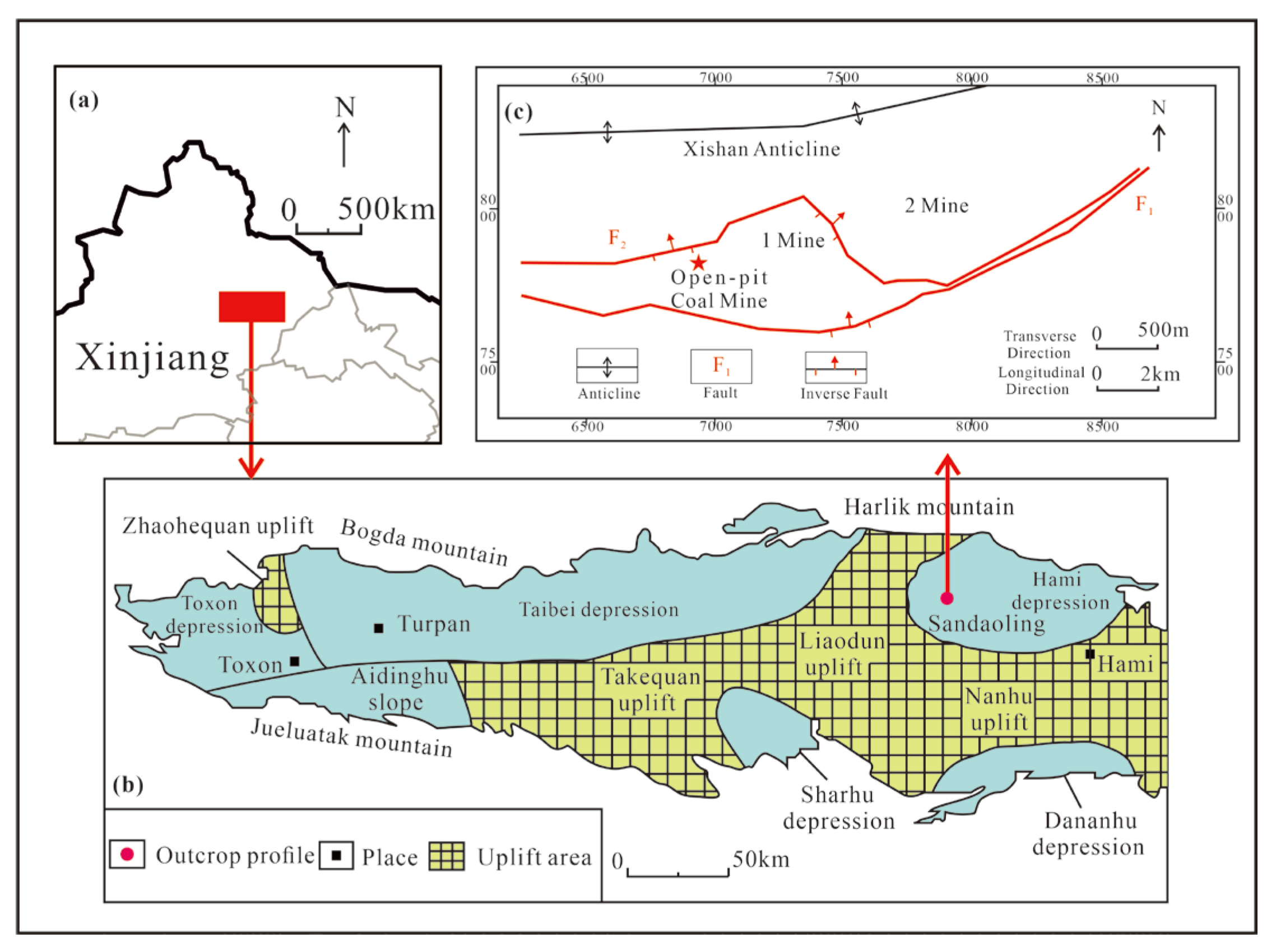

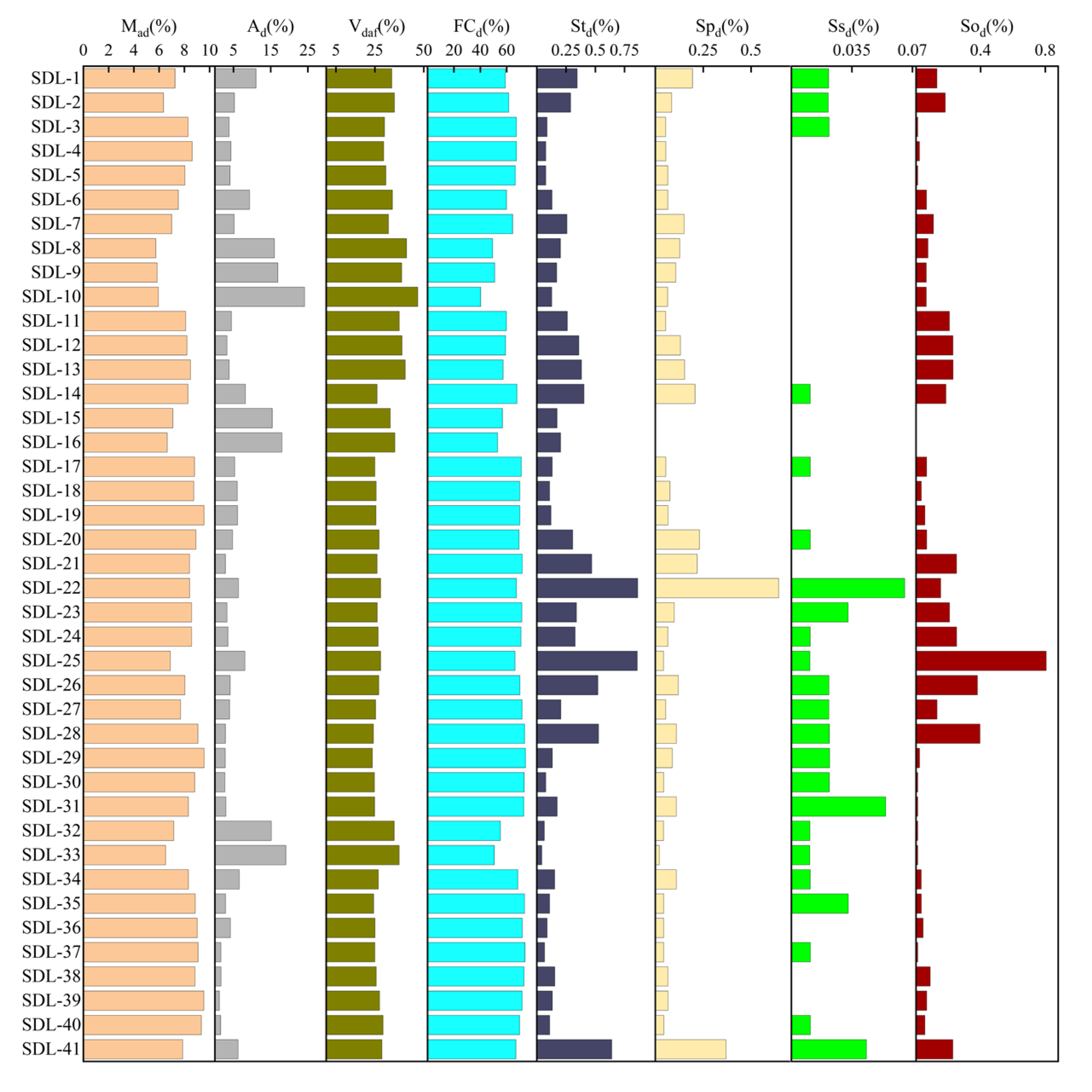
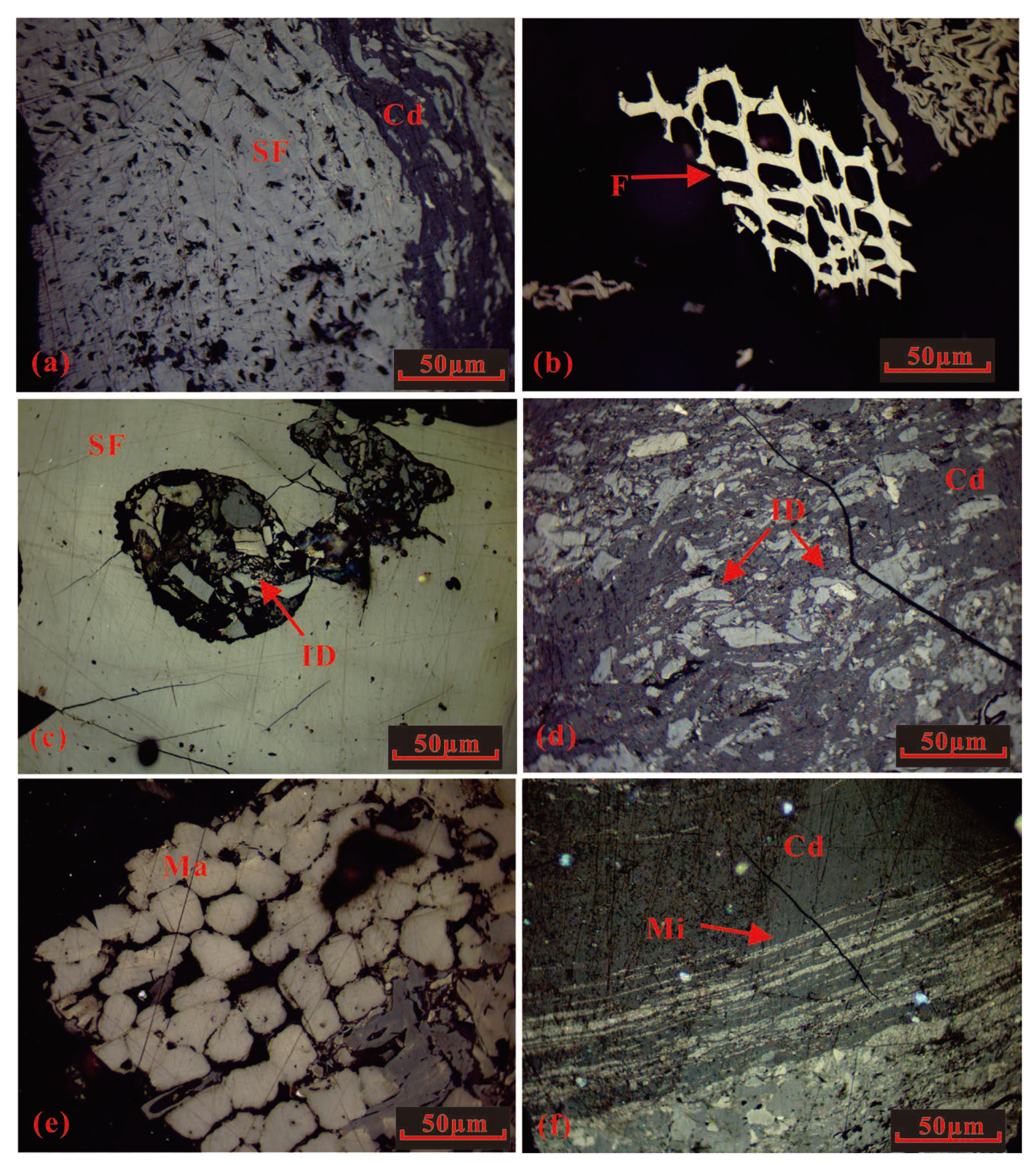

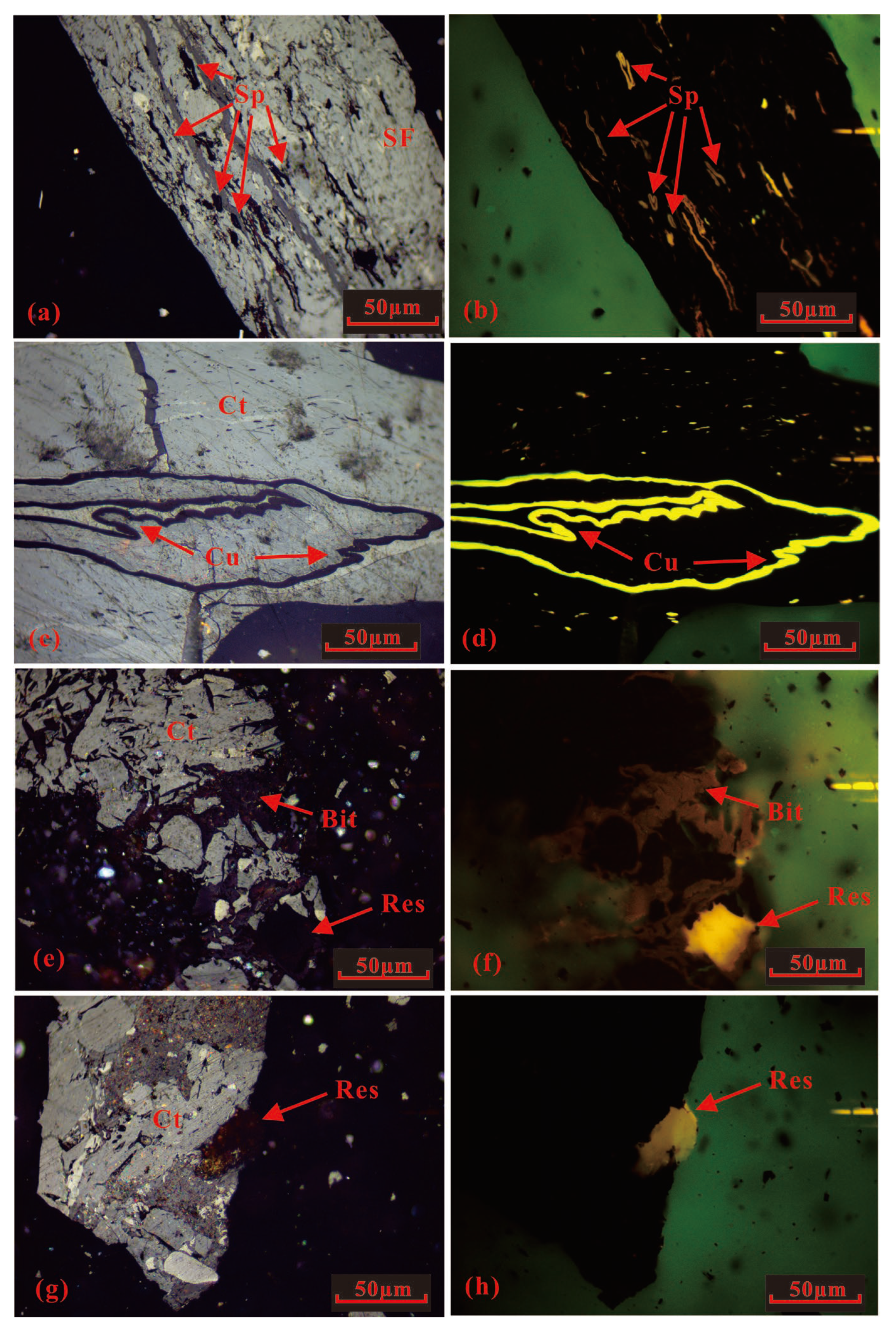
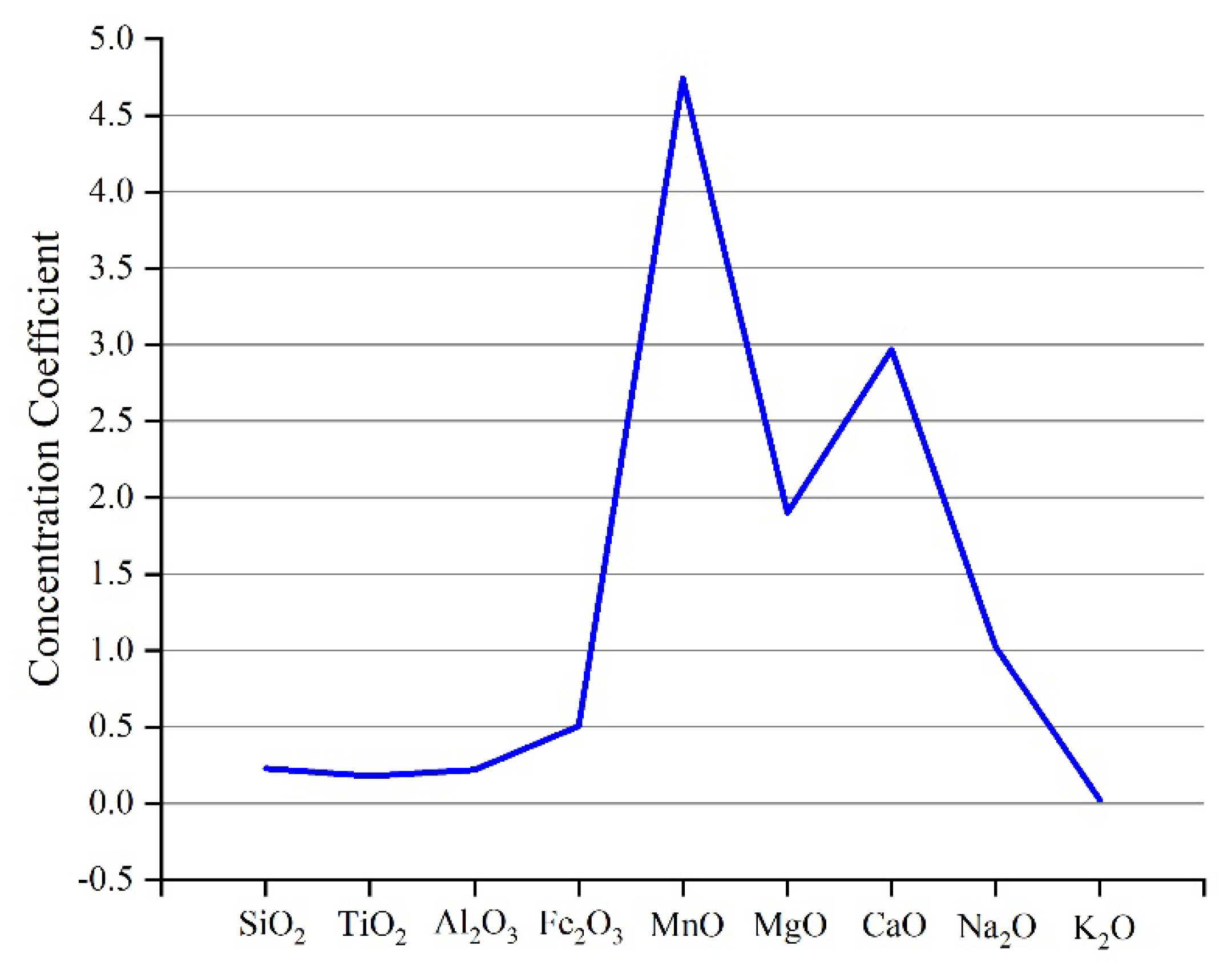
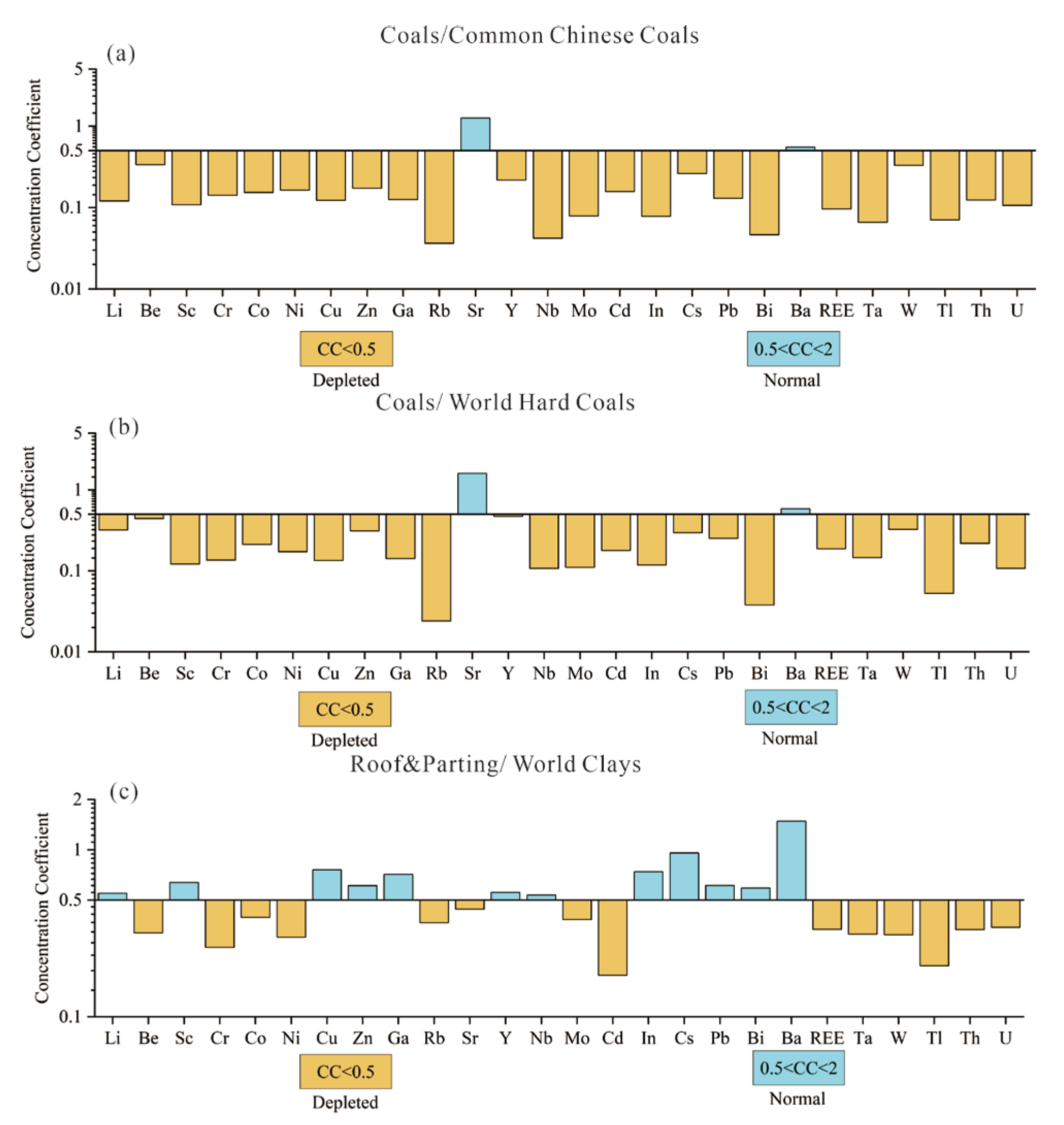
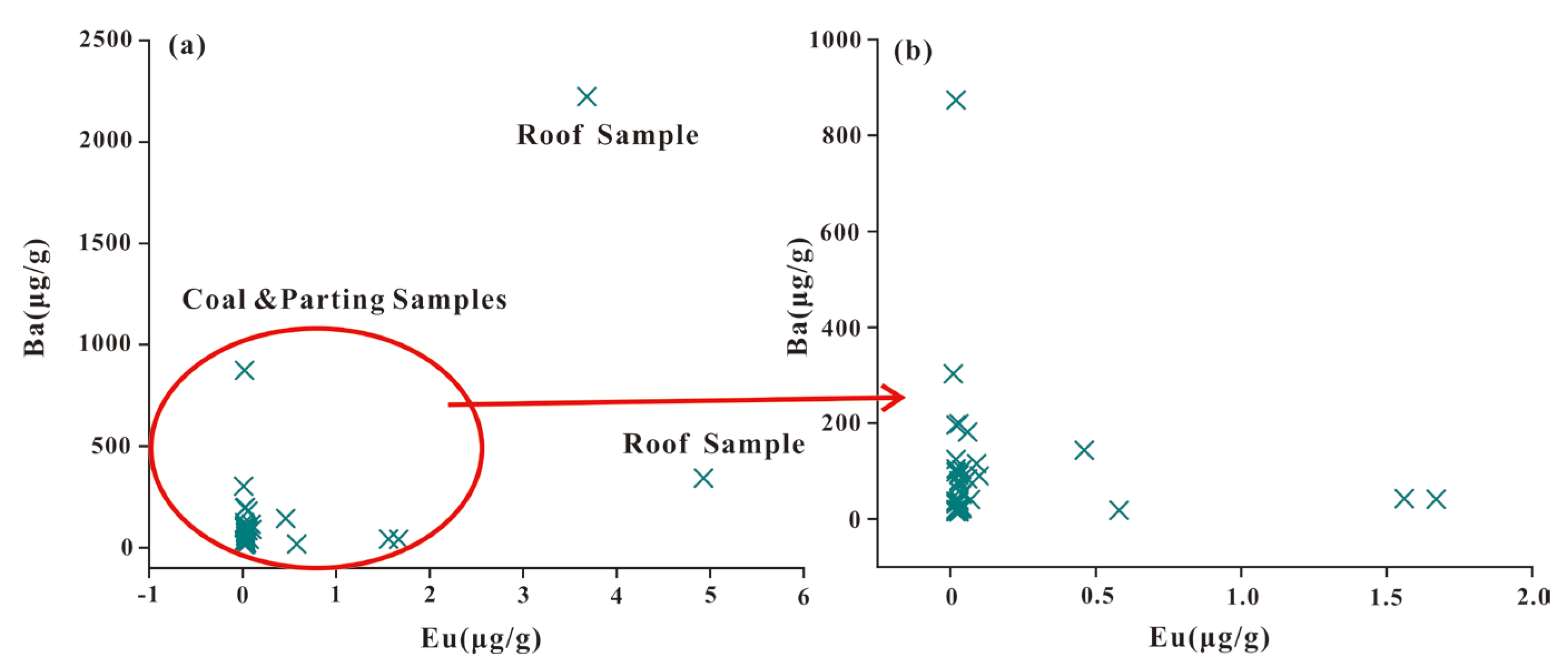
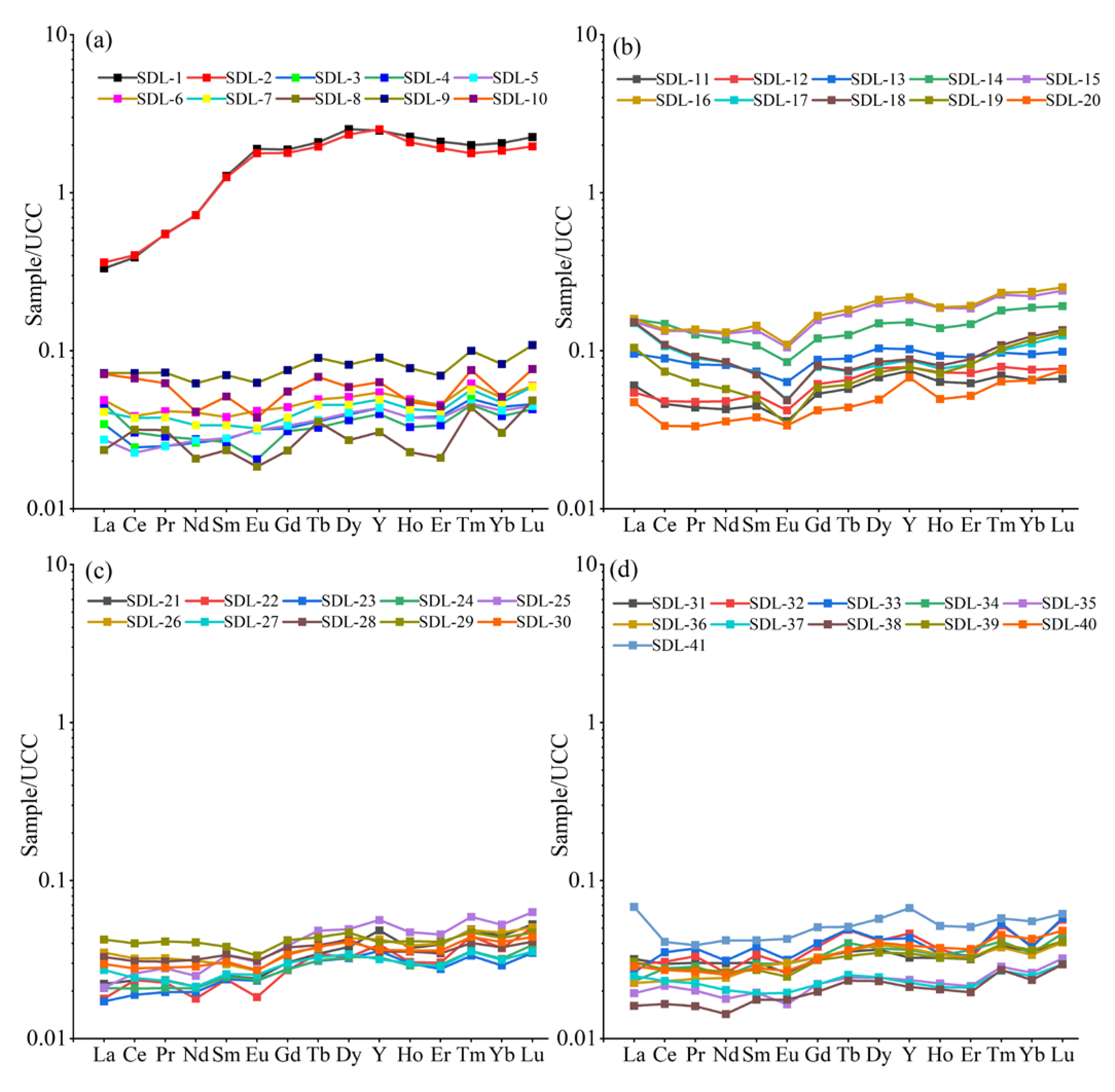
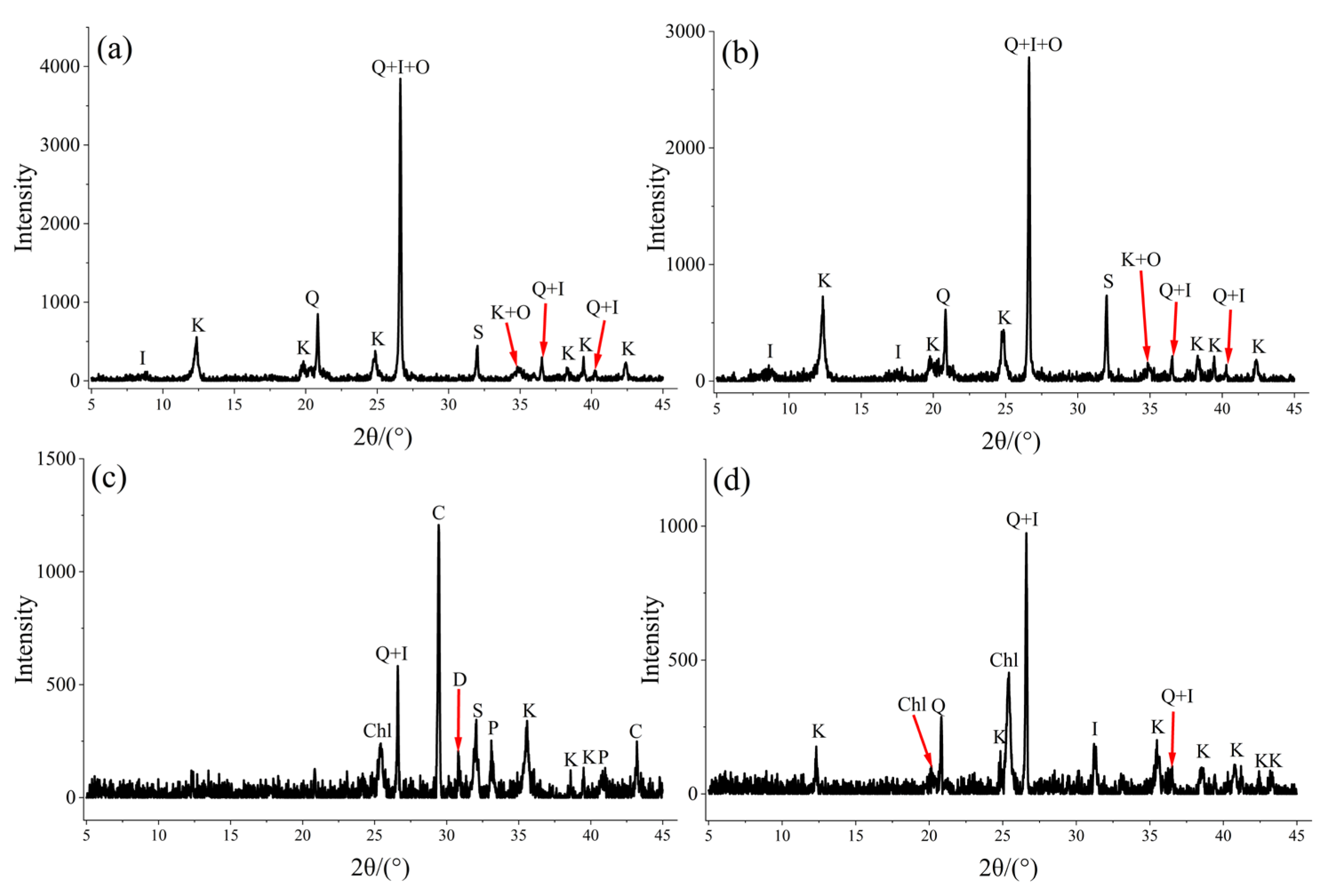
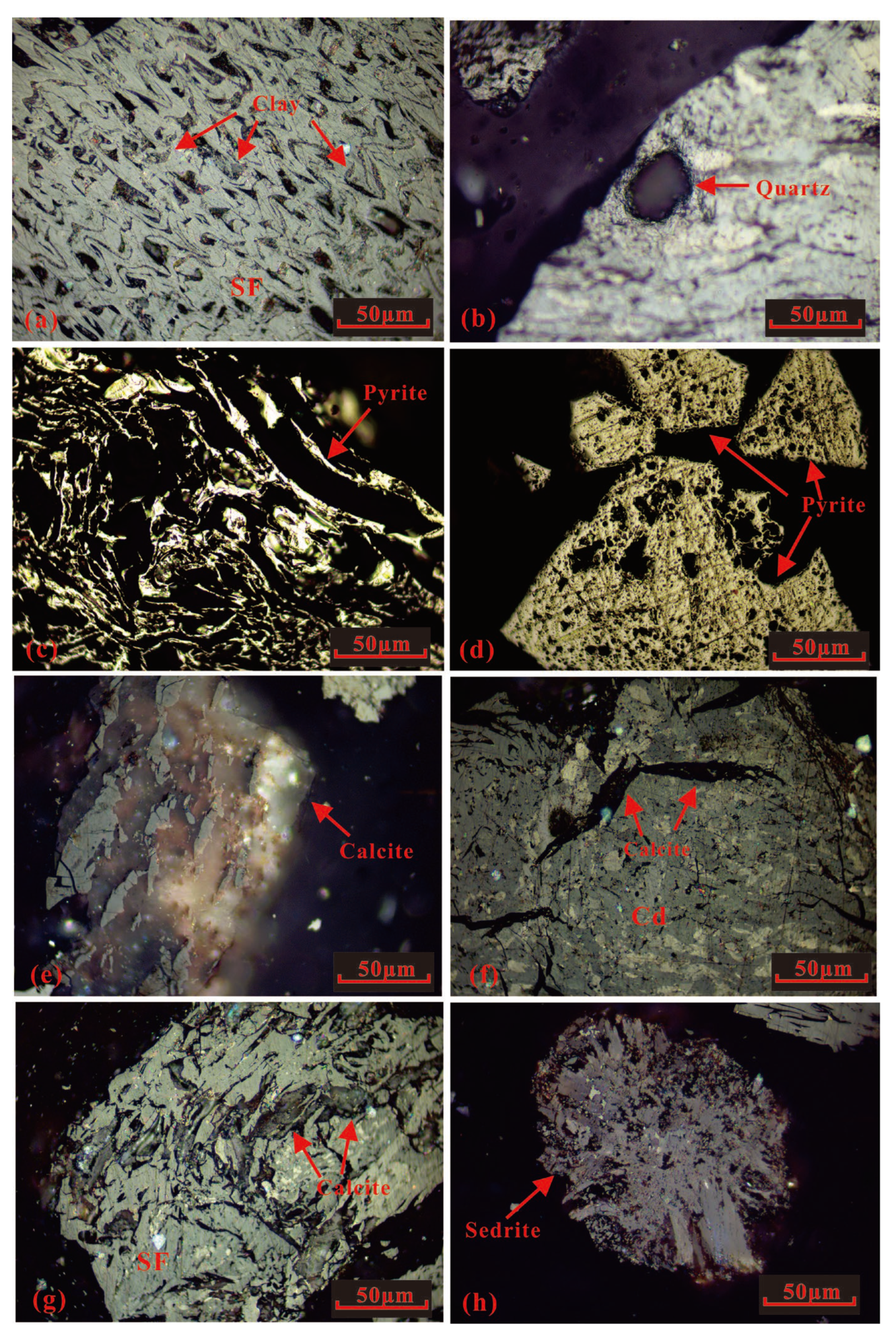
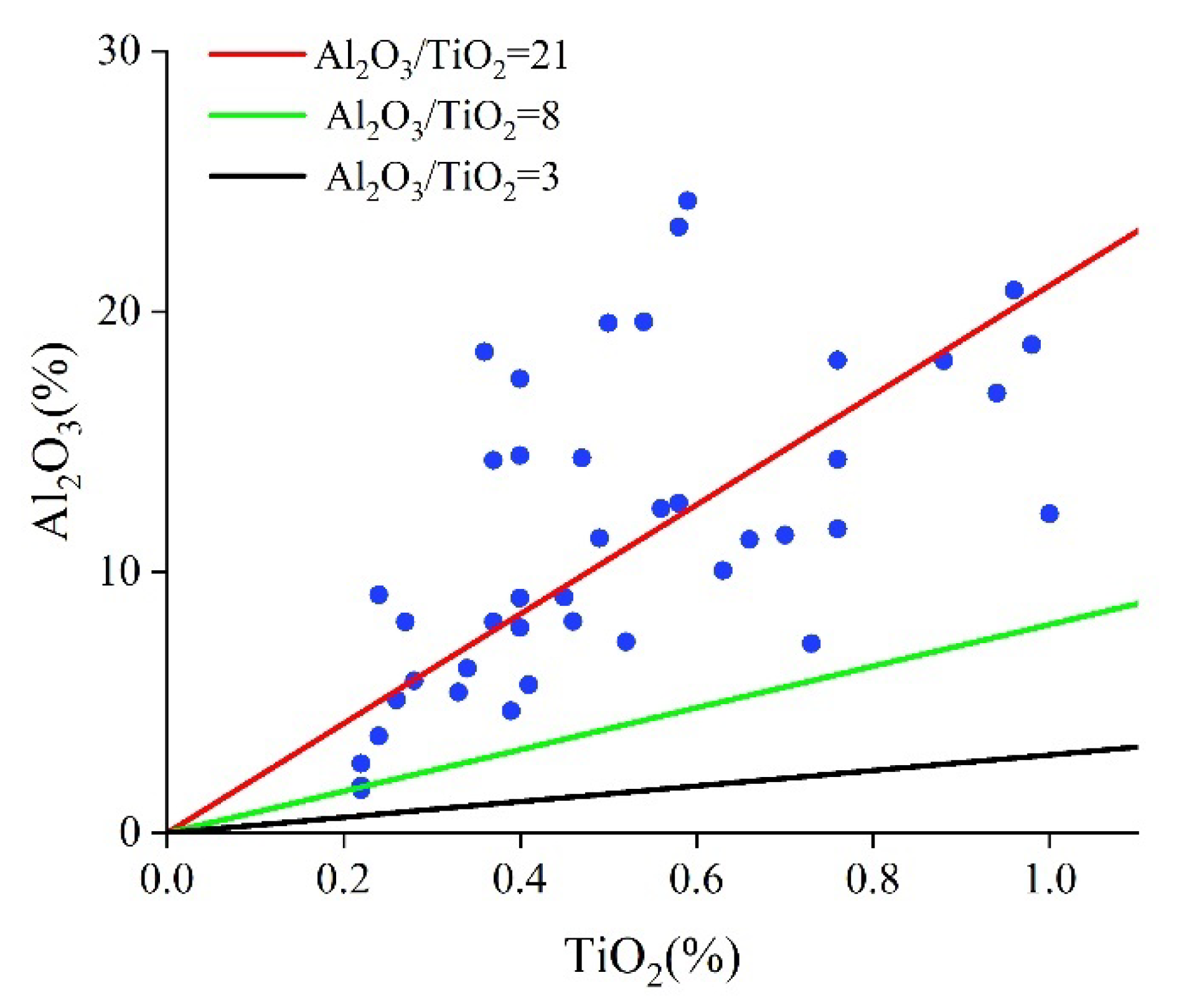
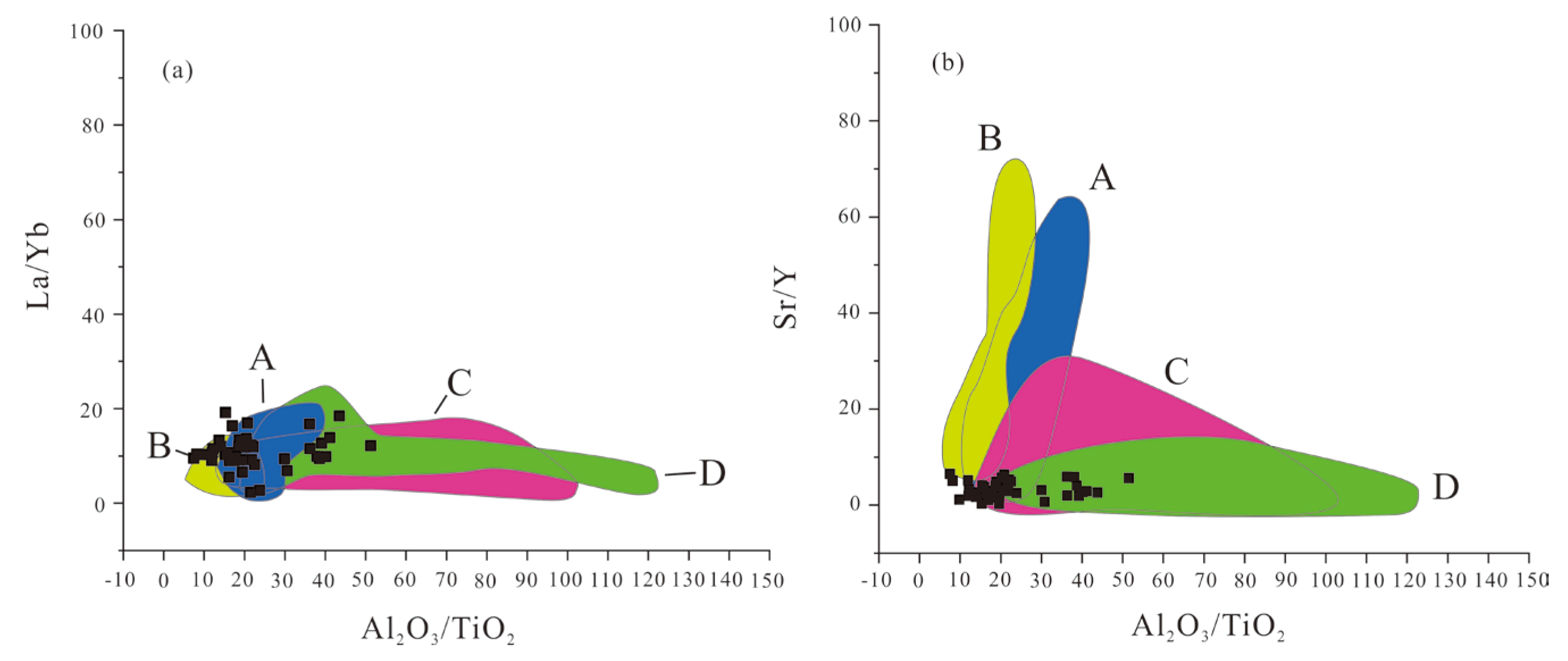
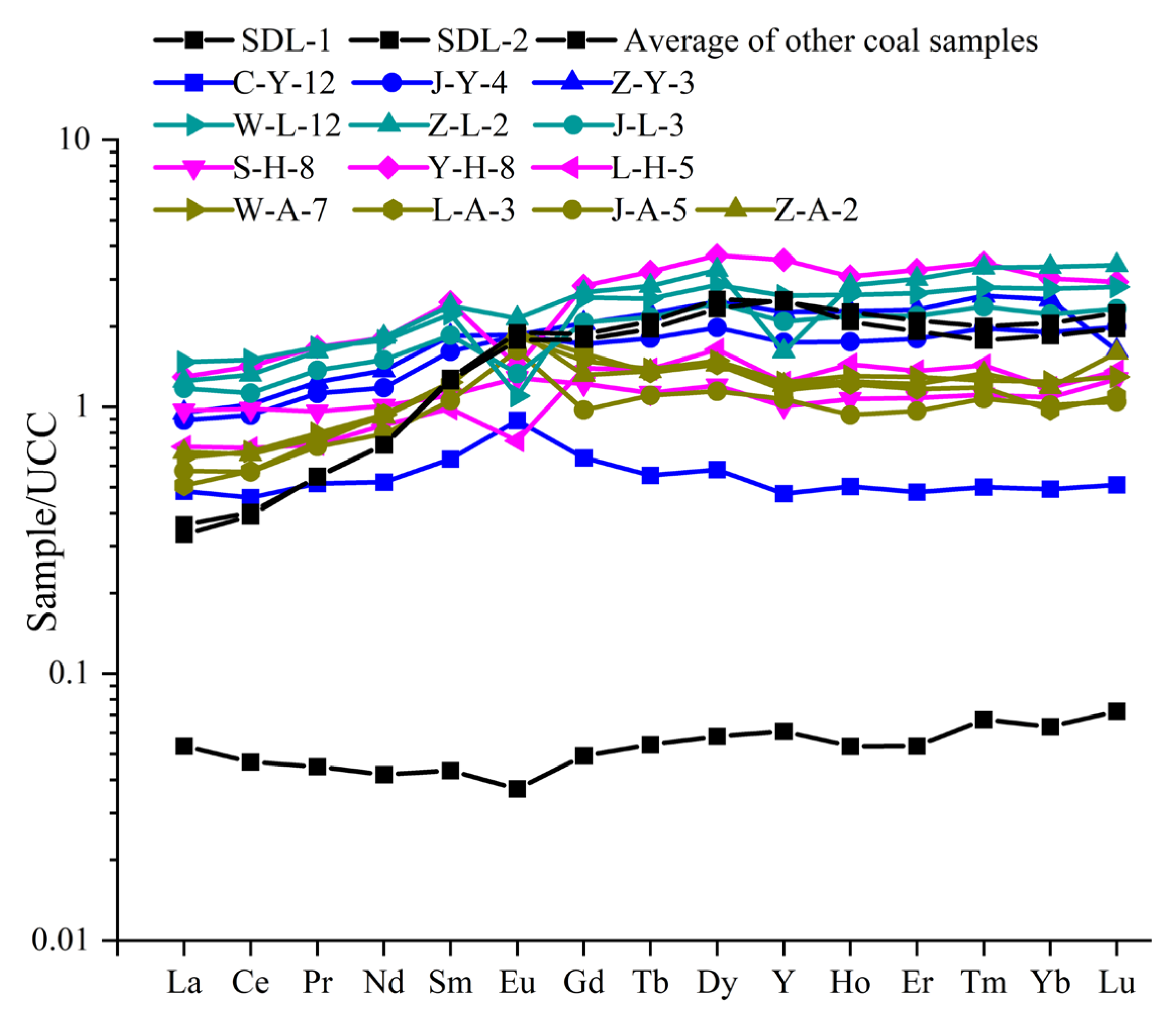
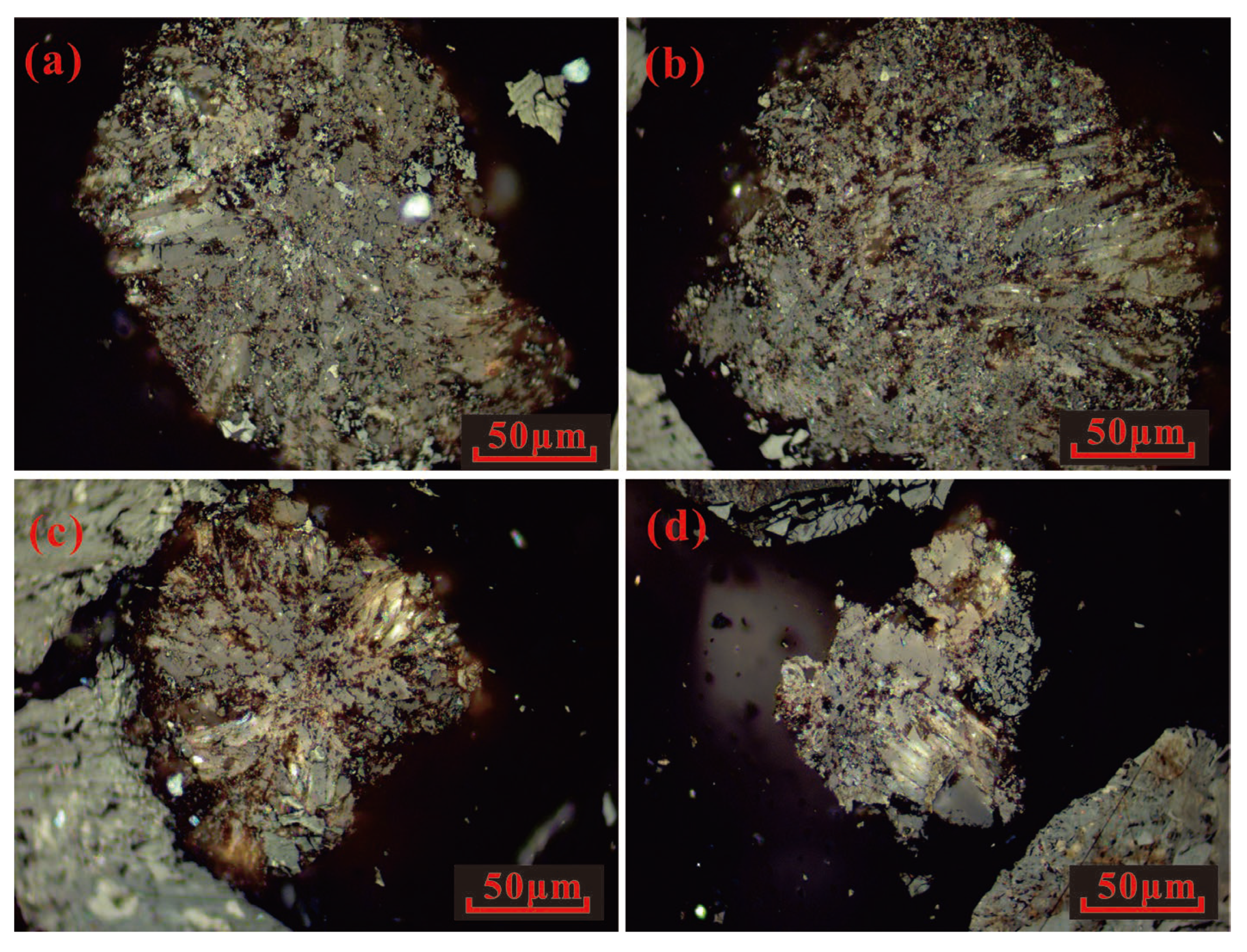
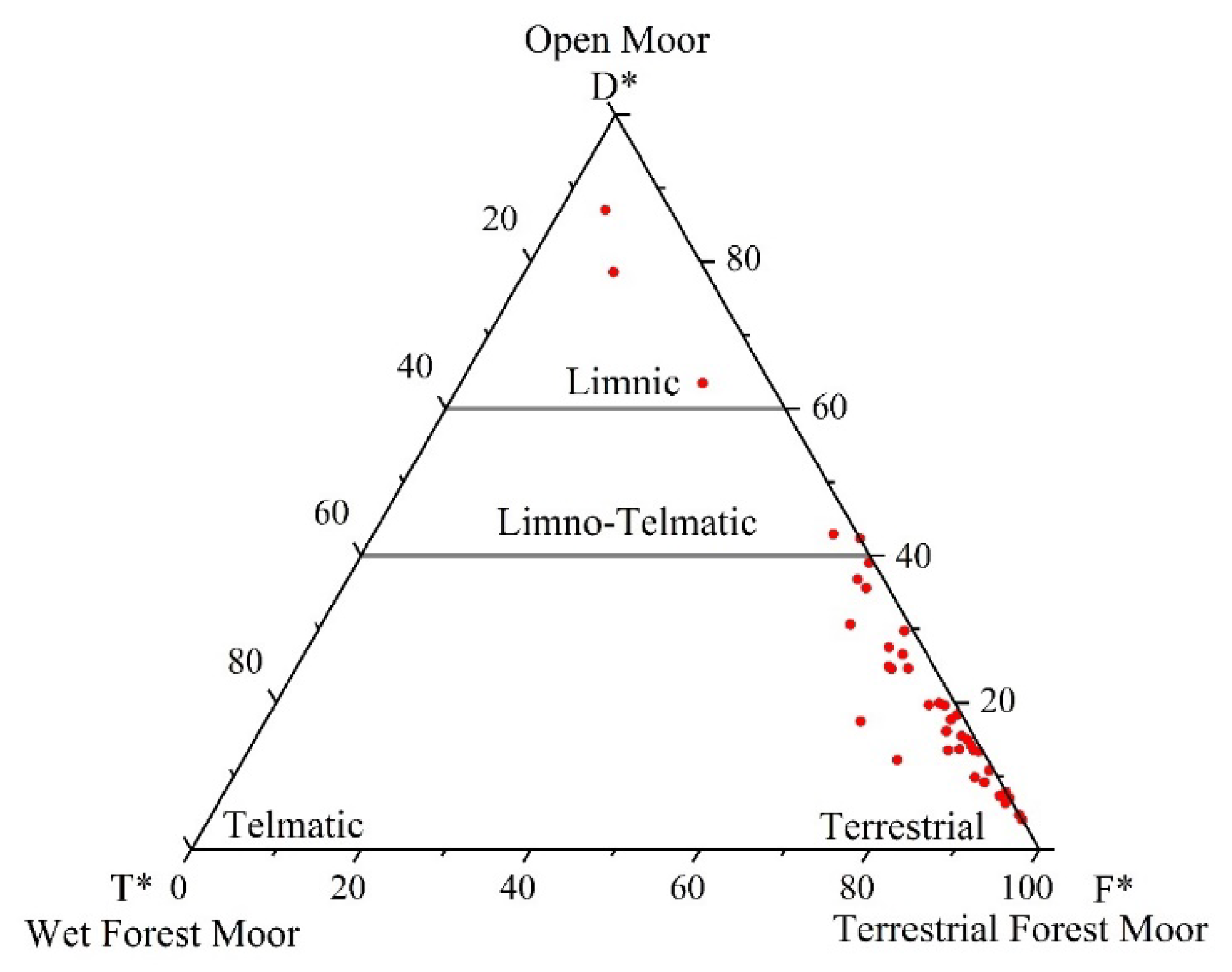
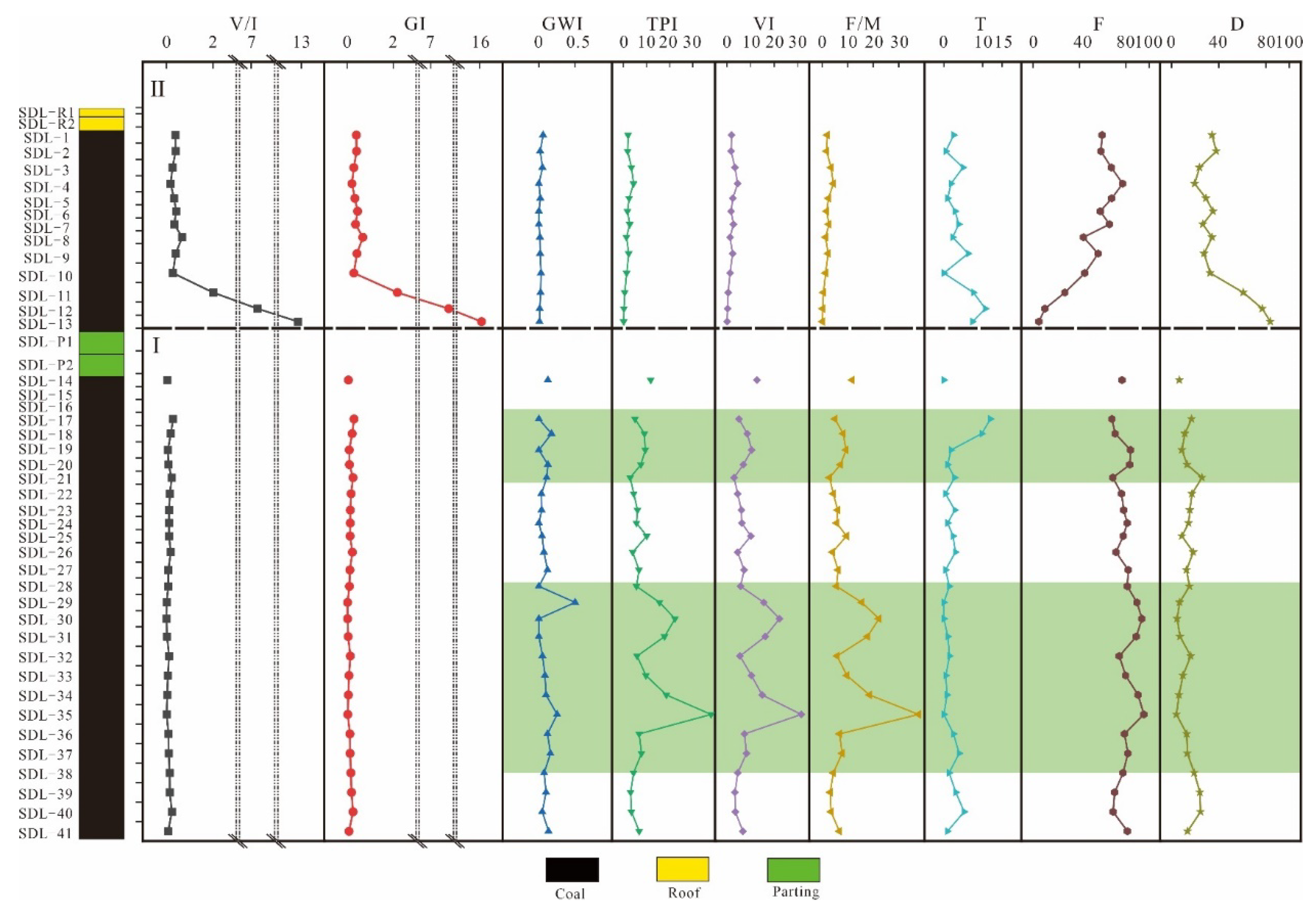
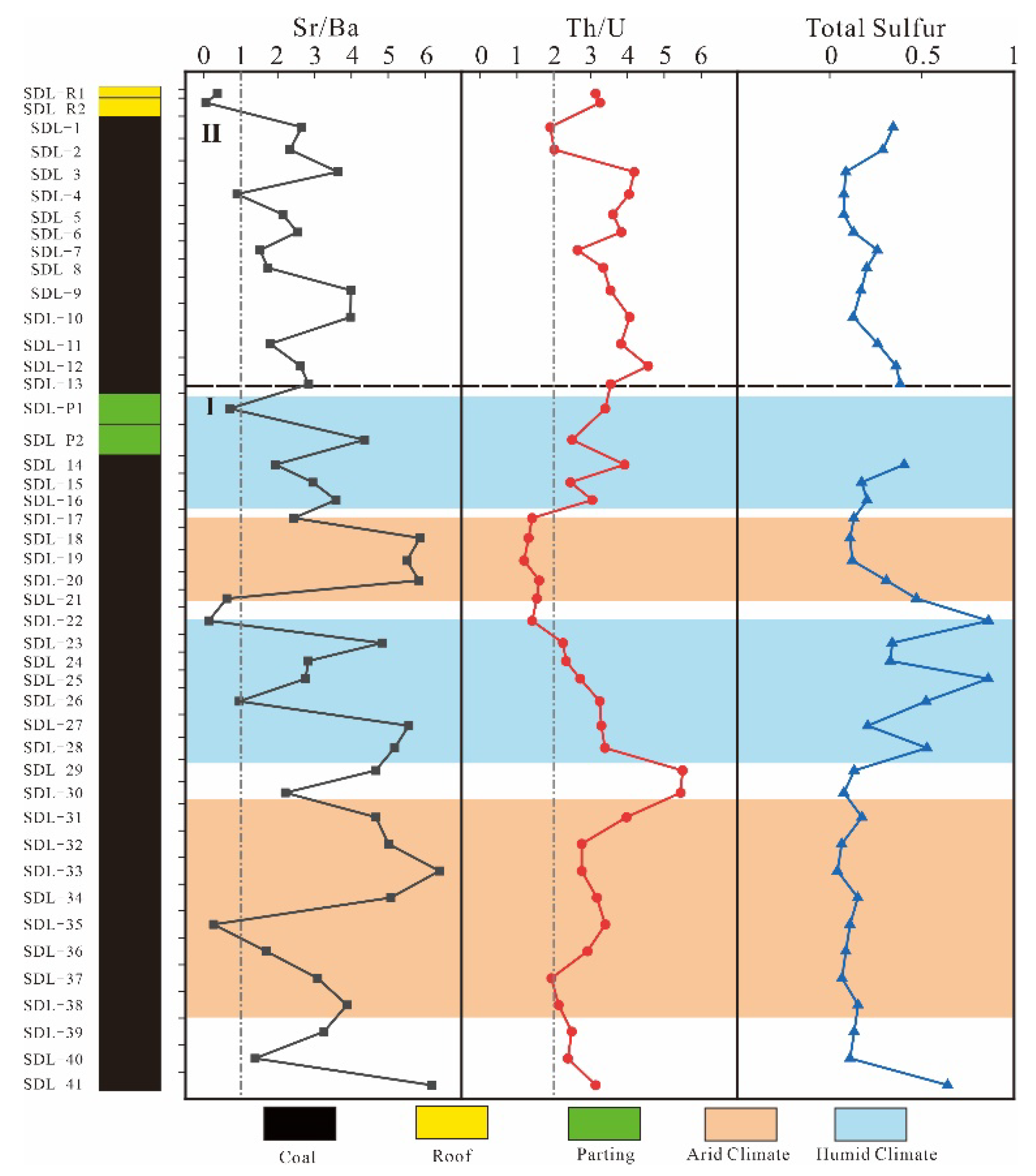
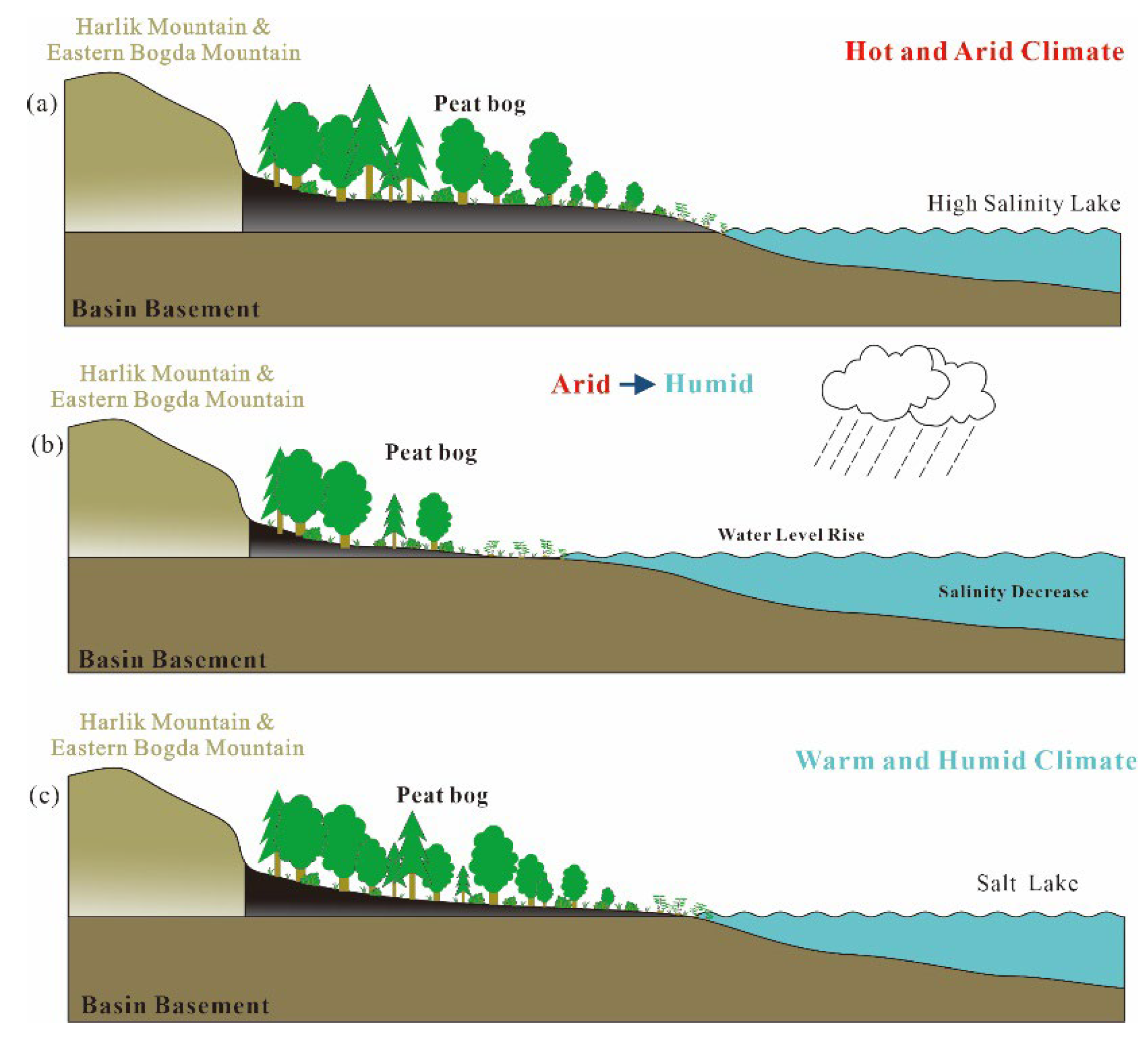
| Sample | Quartz | Orthoclase | Calcite | Dolomite | Siderite | Pyrite | TCCM |
|---|---|---|---|---|---|---|---|
| SDL-R1 | 52.0 | 4.0 | - | - | 5.0 | - | 39.0 |
| SDL-R2 | 46.0 | 3.0 | - | - | 15.0 | - | 36.0 |
| SDL-P1 | 14.0 | - | 37.0 | 10.0 | 12.0 | 2.0 | 25.0 |
| SDL-P2 | 32.0 | - | - | - | - | - | 68.0 |
| Average | 36.0 | 1.75 | 9.3 | 2.5 | 8.0 | 0.5 | 42.0 |
| Sample | Sr/Ba | Th/U | Total Sulfur | V/I | GI | TPI | GWI | VI | F/M | T | F | D |
|---|---|---|---|---|---|---|---|---|---|---|---|---|
| SDL-R1 | 0.36 | 3.14 | - | - | - | - | - | - | - | - | - | - |
| SDL-R2 | 0.05 | 3.26 | - | - | - | - | - | - | - | - | - | - |
| SDL-1 | 2.65 | 1.91 | 0.35 | 0.39 | 0.39 | 2.02 | 0.06 | 1.98 | 2.02 | 2.53 | 59.60 | 34.34 |
| SDL-2 | 2.33 | 2.02 | 0.29 | 0.41 | 0.41 | 1.84 | 0.02 | 1.81 | 1.84 | 0.52 | 58.55 | 37.82 |
| SDL-3 | 3.64 | 4.19 | 0.09 | 0.27 | 0.29 | 3.50 | 0.05 | 3.42 | 3.50 | 4.93 | 67.49 | 23.65 |
| SDL-4 | 0.90 | 4.04 | 0.08 | 0.19 | 0.20 | 4.44 | 0.00 | 4.55 | 4.44 | 1.83 | 77.17 | 19.63 |
| SDL-5 | 2.14 | 3.61 | 0.08 | 0.34 | 0.34 | 2.54 | 0.02 | 2.54 | 2.54 | 1.01 | 67.84 | 29.15 |
| SDL-6 | 2.54 | 3.83 | 0.13 | 0.43 | 0.45 | 1.80 | 0.00 | 1.80 | 1.80 | 2.94 | 57.84 | 35.29 |
| SDL-7 | 1.52 | 2.65 | 0.26 | 0.34 | 0.36 | 2.74 | 0.00 | 2.79 | 2.74 | 3.85 | 65.87 | 26.44 |
| SDL-8 | 1.74 | 3.35 | 0.20 | 0.68 | 0.68 | 1.36 | 0.01 | 1.36 | 1.36 | 2.26 | 43.44 | 34.39 |
| SDL-9 | 3.99 | 3.54 | 0.17 | 0.40 | 0.43 | 2.35 | 0.02 | 2.43 | 2.35 | 6.28 | 56.04 | 27.54 |
| SDL-10 | 3.98 | 4.06 | 0.13 | 0.28 | 0.28 | 1.41 | 0.03 | 1.41 | 1.41 | 0.00 | 44.55 | 32.67 |
| SDL-11 | 1.80 | 3.83 | 0.26 | 2.00 | 2.19 | 0.58 | 0.02 | 0.59 | 0.58 | 7.61 | 27.41 | 60.91 |
| SDL-12 | 2.62 | 4.56 | 0.36 | 7.27 | 7.79 | 0.28 | 0.01 | 0.28 | 0.28 | 10.69 | 10.30 | 77.03 |
| SDL-13 | 2.84 | 3.55 | 0.38 | 12.87 | 16.08 | 0.15 | 0.01 | 0.15 | 0.15 | 7.41 | 5.09 | 83.80 |
| SDL-P1 | 0.70 | 3.40 | - | - | - | - | - | - | - | - | - | - |
| SDL-P2 | 4.36 | 2.50 | - | - | - | - | - | - | - | - | - | - |
| SDL-14 | 1.94 | 3.93 | 0.40 | 0.05 | 0.05 | 11.79 | 0.13 | 12.69 | 11.79 | 0.00 | 76.74 | 6.51 |
| SDL-15 | 2.95 | 2.46 | 0.17 | - | - | - | - | - | - | - | - | - |
| SDL-16 | 3.59 | 3.05 | 0.20 | - | - | - | - | - | - | - | - | - |
| SDL-17 | 2.44 | 1.41 | 0.13 | 0.29 | 0.29 | 5.07 | 0.00 | 5.07 | 5.07 | 11.96 | 67.93 | 16.85 |
| SDL-18 | 5.86 | 1.32 | 0.11 | 0.20 | 0.21 | 9.11 | 0.17 | 8.65 | 8.24 | 9.77 | 70.70 | 11.16 |
| SDL-19 | 5.50 | 1.20 | 0.12 | 0.07 | 0.08 | 9.45 | 0.00 | 10.50 | 9.45 | 1.82 | 84.09 | 8.64 |
| SDL-20 | 5.84 | 1.61 | 0.31 | 0.10 | 0.10 | 7.52 | 0.13 | 6.92 | 7.21 | 0.98 | 83.41 | 13.17 |
| SDL-21 | 0.62 | 1.55 | 0.47 | 0.23 | 0.25 | 2.98 | 0.11 | 3.04 | 2.92 | 2.76 | 68.66 | 25.81 |
| SDL-22 | 0.13 | 1.41 | 0.86 | 0.16 | 0.17 | 4.45 | 0.04 | 4.57 | 4.45 | 0.45 | 76.36 | 17.27 |
| SDL-23 | 4.83 | 2.26 | 0.34 | 0.12 | 0.13 | 6.15 | 0.04 | 6.15 | 6.15 | 2.79 | 78.09 | 15.54 |
| SDL-24 | 2.83 | 2.33 | 0.33 | 0.12 | 0.14 | 5.70 | 0.00 | 6.33 | 5.70 | 0.96 | 81.25 | 14.42 |
| SDL-25 | 2.76 | 2.71 | 0.86 | 0.12 | 0.12 | 10.10 | 0.05 | 10.10 | 9.62 | 2.38 | 77.78 | 8.73 |
| SDL-26 | 0.96 | 3.25 | 0.52 | 0.19 | 0.23 | 4.08 | 0.07 | 4.58 | 4.08 | 2.96 | 71.43 | 18.23 |
| SDL-27 | 5.56 | 3.30 | 0.21 | 0.10 | 0.12 | 6.75 | 0.12 | 7.27 | 6.30 | 0.44 | 82.10 | 12.66 |
| SDL-28 | 5.17 | 3.39 | 0.53 | 0.09 | 0.10 | 5.65 | 0.00 | 5.83 | 5.65 | 1.42 | 81.13 | 15.09 |
| SDL-29 | 4.65 | 5.50 | 0.13 | 0.02 | 0.02 | 15.58 | 0.50 | 15.58 | 15.58 | 0.00 | 89.47 | 6.70 |
| SDL-30 | 2.21 | 5.44 | 0.08 | 0.01 | 0.02 | 22.30 | 0.00 | 22.30 | 22.30 | 0.00 | 93.70 | 4.62 |
| SDL-31 | 4.66 | 3.97 | 0.17 | 0.04 | 0.04 | 17.80 | 0.00 | 16.20 | 17.80 | 1.01 | 88.89 | 7.07 |
| SDL-32 | 5.01 | 2.76 | 0.06 | 0.12 | 0.13 | 5.92 | 0.05 | 5.50 | 5.92 | 1.48 | 74.38 | 16.26 |
| SDL-33 | 6.39 | 2.76 | 0.04 | 0.07 | 0.08 | 9.76 | 0.08 | 10.38 | 9.76 | 0.48 | 79.71 | 9.66 |
| SDL-34 | 5.07 | 3.17 | 0.15 | 0.05 | 0.05 | 18.58 | 0.10 | 14.94 | 18.58 | 0.82 | 90.57 | 6.12 |
| SDL-35 | 0.26 | 3.40 | 0.11 | 0.02 | 0.02 | 37.80 | 0.25 | 31.50 | 37.80 | 0.00 | 95.45 | 4.04 |
| SDL-36 | 1.68 | 2.92 | 0.09 | 0.10 | 0.11 | 6.88 | 0.12 | 7.50 | 6.88 | 2.46 | 78.82 | 12.81 |
| SDL-37 | 3.08 | 1.94 | 0.07 | 0.11 | 0.12 | 7.86 | 0.16 | 8.24 | 7.86 | 3.96 | 81.68 | 13.37 |
| SDL-38 | 3.88 | 2.13 | 0.15 | 0.14 | 0.16 | 4.40 | 0.07 | 4.63 | 4.40 | 1.35 | 77.58 | 19.28 |
| SDL-39 | 3.26 | 2.49 | 0.13 | 0.16 | 0.19 | 3.17 | 0.10 | 3.43 | 3.17 | 3.06 | 70.31 | 24.02 |
| SDL-40 | 1.39 | 2.38 | 0.11 | 0.25 | 0.25 | 3.52 | 0.05 | 3.60 | 3.52 | 5.26 | 68.86 | 24.56 |
| SDL-41 | 6.18 | 3.13 | 0.64 | 0.08 | 0.08 | 6.81 | 0.13 | 6.81 | 6.81 | 0.93 | 81.40 | 13.49 |
| Average | 3.04 | 2.99 | 0.25 | 0.74 | 0.85 | 7.03 | 0.07 | 6.86 | 6.97 | 2.85 | 69.53 | 22.28 |
Disclaimer/Publisher’s Note: The statements, opinions and data contained in all publications are solely those of the individual author(s) and contributor(s) and not of MDPI and/or the editor(s). MDPI and/or the editor(s) disclaim responsibility for any injury to people or property resulting from any ideas, methods, instructions or products referred to in the content. |
© 2023 by the authors. Licensee MDPI, Basel, Switzerland. This article is an open access article distributed under the terms and conditions of the Creative Commons Attribution (CC BY) license (https://creativecommons.org/licenses/by/4.0/).
Share and Cite
Wei, J.; Wei, Y.; Qin, G.; Ning, S.; Cao, D.; Wang, A. Geochemistry, Mineralogy, and Coal Petrology of No. 4 Coal in Sandaoling Mine, Turpan-Hami Basin, Northwest China: Provenance and Peat Depositional Environment. Minerals 2023, 13, 837. https://doi.org/10.3390/min13070837
Wei J, Wei Y, Qin G, Ning S, Cao D, Wang A. Geochemistry, Mineralogy, and Coal Petrology of No. 4 Coal in Sandaoling Mine, Turpan-Hami Basin, Northwest China: Provenance and Peat Depositional Environment. Minerals. 2023; 13(7):837. https://doi.org/10.3390/min13070837
Chicago/Turabian StyleWei, Jinhao, Yingchun Wei, Guohong Qin, Shuzheng Ning, Daiyong Cao, and Anmin Wang. 2023. "Geochemistry, Mineralogy, and Coal Petrology of No. 4 Coal in Sandaoling Mine, Turpan-Hami Basin, Northwest China: Provenance and Peat Depositional Environment" Minerals 13, no. 7: 837. https://doi.org/10.3390/min13070837
APA StyleWei, J., Wei, Y., Qin, G., Ning, S., Cao, D., & Wang, A. (2023). Geochemistry, Mineralogy, and Coal Petrology of No. 4 Coal in Sandaoling Mine, Turpan-Hami Basin, Northwest China: Provenance and Peat Depositional Environment. Minerals, 13(7), 837. https://doi.org/10.3390/min13070837






